International Mobility and Cultural Adjustment (Doc)
VerifiedAdded on 2020/04/15
|23
|5323
|37
AI Summary
Contribute Materials
Your contribution can guide someone’s learning journey. Share your
documents today.
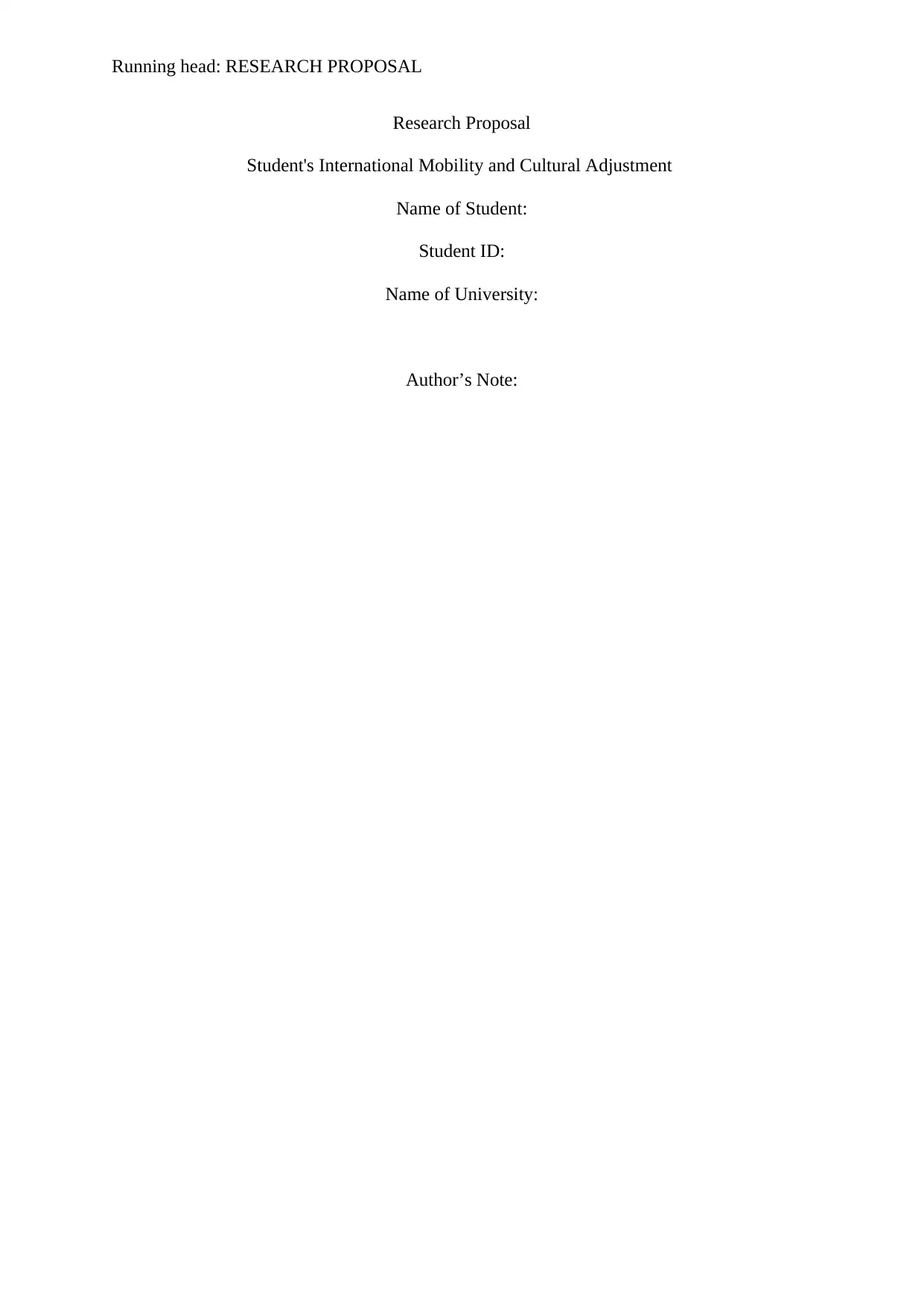
Running head: RESEARCH PROPOSAL
Research Proposal
Student's International Mobility and Cultural Adjustment
Name of Student:
Student ID:
Name of University:
Author’s Note:
Research Proposal
Student's International Mobility and Cultural Adjustment
Name of Student:
Student ID:
Name of University:
Author’s Note:
Secure Best Marks with AI Grader
Need help grading? Try our AI Grader for instant feedback on your assignments.
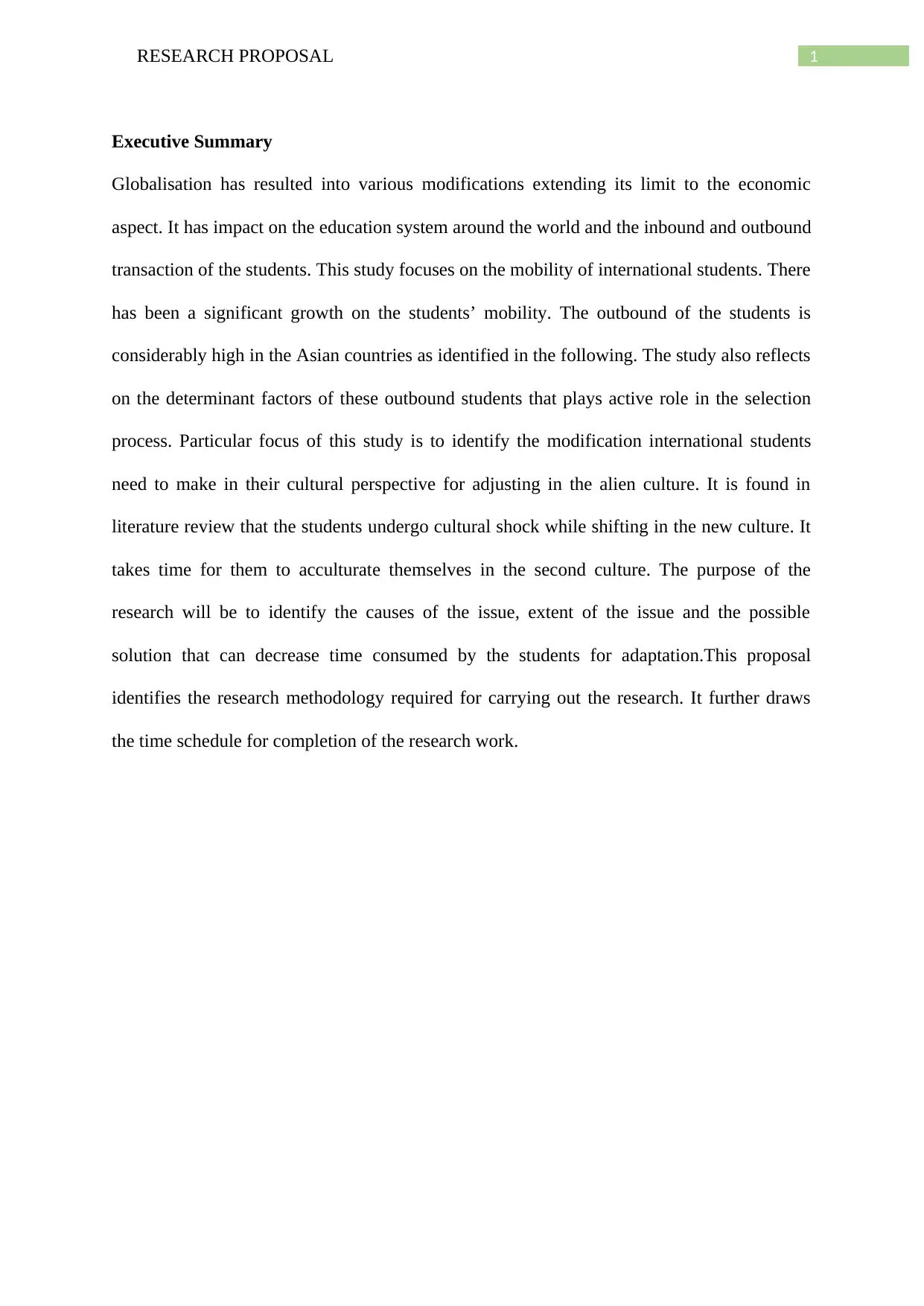
1RESEARCH PROPOSAL
Executive Summary
Globalisation has resulted into various modifications extending its limit to the economic
aspect. It has impact on the education system around the world and the inbound and outbound
transaction of the students. This study focuses on the mobility of international students. There
has been a significant growth on the students’ mobility. The outbound of the students is
considerably high in the Asian countries as identified in the following. The study also reflects
on the determinant factors of these outbound students that plays active role in the selection
process. Particular focus of this study is to identify the modification international students
need to make in their cultural perspective for adjusting in the alien culture. It is found in
literature review that the students undergo cultural shock while shifting in the new culture. It
takes time for them to acculturate themselves in the second culture. The purpose of the
research will be to identify the causes of the issue, extent of the issue and the possible
solution that can decrease time consumed by the students for adaptation.This proposal
identifies the research methodology required for carrying out the research. It further draws
the time schedule for completion of the research work.
Executive Summary
Globalisation has resulted into various modifications extending its limit to the economic
aspect. It has impact on the education system around the world and the inbound and outbound
transaction of the students. This study focuses on the mobility of international students. There
has been a significant growth on the students’ mobility. The outbound of the students is
considerably high in the Asian countries as identified in the following. The study also reflects
on the determinant factors of these outbound students that plays active role in the selection
process. Particular focus of this study is to identify the modification international students
need to make in their cultural perspective for adjusting in the alien culture. It is found in
literature review that the students undergo cultural shock while shifting in the new culture. It
takes time for them to acculturate themselves in the second culture. The purpose of the
research will be to identify the causes of the issue, extent of the issue and the possible
solution that can decrease time consumed by the students for adaptation.This proposal
identifies the research methodology required for carrying out the research. It further draws
the time schedule for completion of the research work.

2RESEARCH PROPOSAL
Contents
Executive Summary...................................................................................................................1
Introduction................................................................................................................................4
Literature Review.......................................................................................................................4
Student’s International Mobility.............................................................................................4
Asia in relation to Student’s mobility.....................................................................................6
Call for diversification............................................................................................................6
Issues Faced by International Students...................................................................................7
Growing Demand of Post Graduate Students.........................................................................8
Literature Gap.........................................................................................................................8
Research Objective.....................................................................................................................9
Research Question......................................................................................................................9
Significance of the Research......................................................................................................9
Research Methodology.............................................................................................................10
Research Design...................................................................................................................10
Research Philosophy............................................................................................................11
Research Approach...............................................................................................................12
Data Collection and Data Analysis.......................................................................................13
Sampling..................................................................................................................................14
Ethical Consideration...............................................................................................................15
Required Resources..................................................................................................................15
Contents
Executive Summary...................................................................................................................1
Introduction................................................................................................................................4
Literature Review.......................................................................................................................4
Student’s International Mobility.............................................................................................4
Asia in relation to Student’s mobility.....................................................................................6
Call for diversification............................................................................................................6
Issues Faced by International Students...................................................................................7
Growing Demand of Post Graduate Students.........................................................................8
Literature Gap.........................................................................................................................8
Research Objective.....................................................................................................................9
Research Question......................................................................................................................9
Significance of the Research......................................................................................................9
Research Methodology.............................................................................................................10
Research Design...................................................................................................................10
Research Philosophy............................................................................................................11
Research Approach...............................................................................................................12
Data Collection and Data Analysis.......................................................................................13
Sampling..................................................................................................................................14
Ethical Consideration...............................................................................................................15
Required Resources..................................................................................................................15
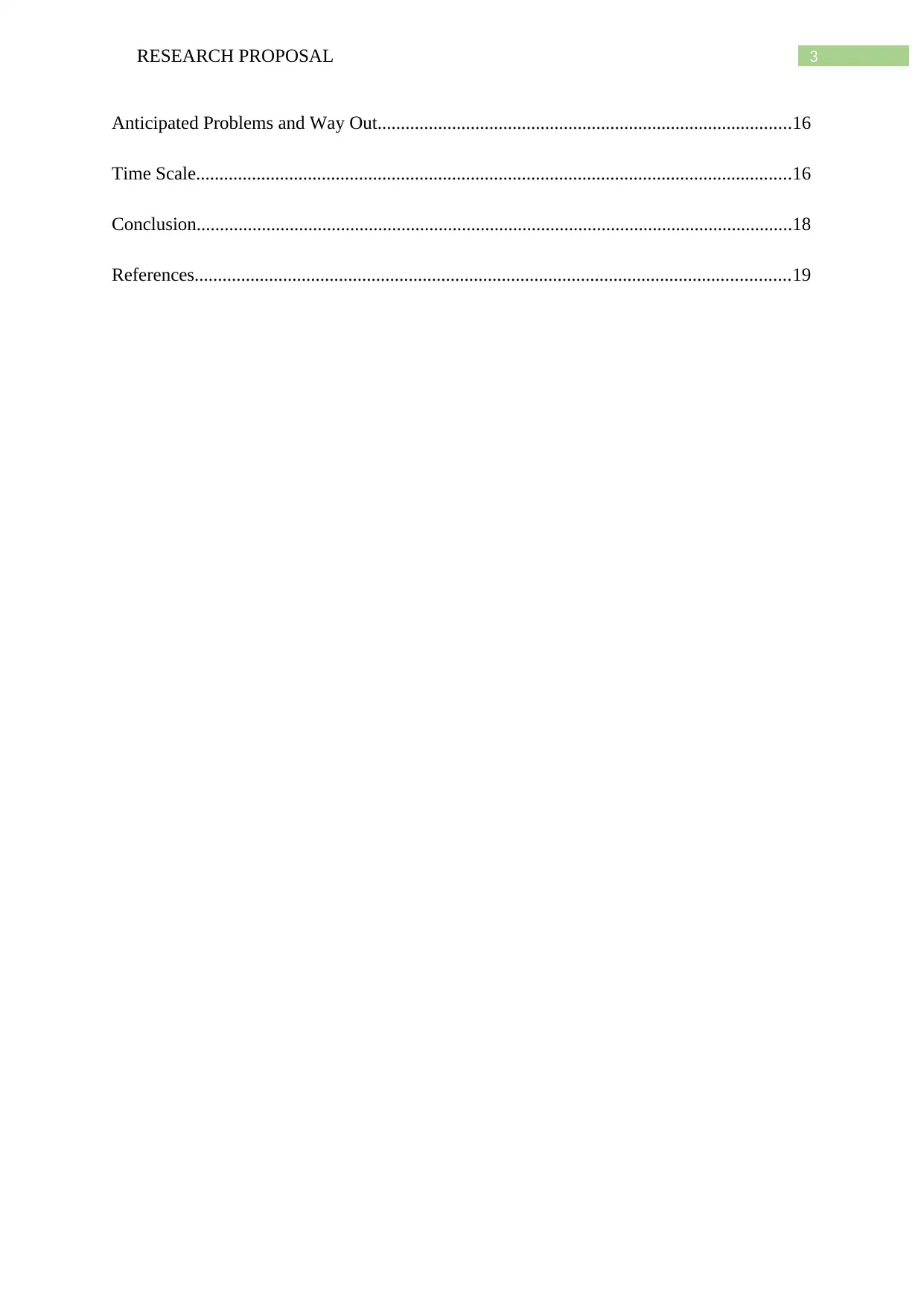
3RESEARCH PROPOSAL
Anticipated Problems and Way Out.........................................................................................16
Time Scale................................................................................................................................16
Conclusion................................................................................................................................18
References................................................................................................................................19
Anticipated Problems and Way Out.........................................................................................16
Time Scale................................................................................................................................16
Conclusion................................................................................................................................18
References................................................................................................................................19
Secure Best Marks with AI Grader
Need help grading? Try our AI Grader for instant feedback on your assignments.
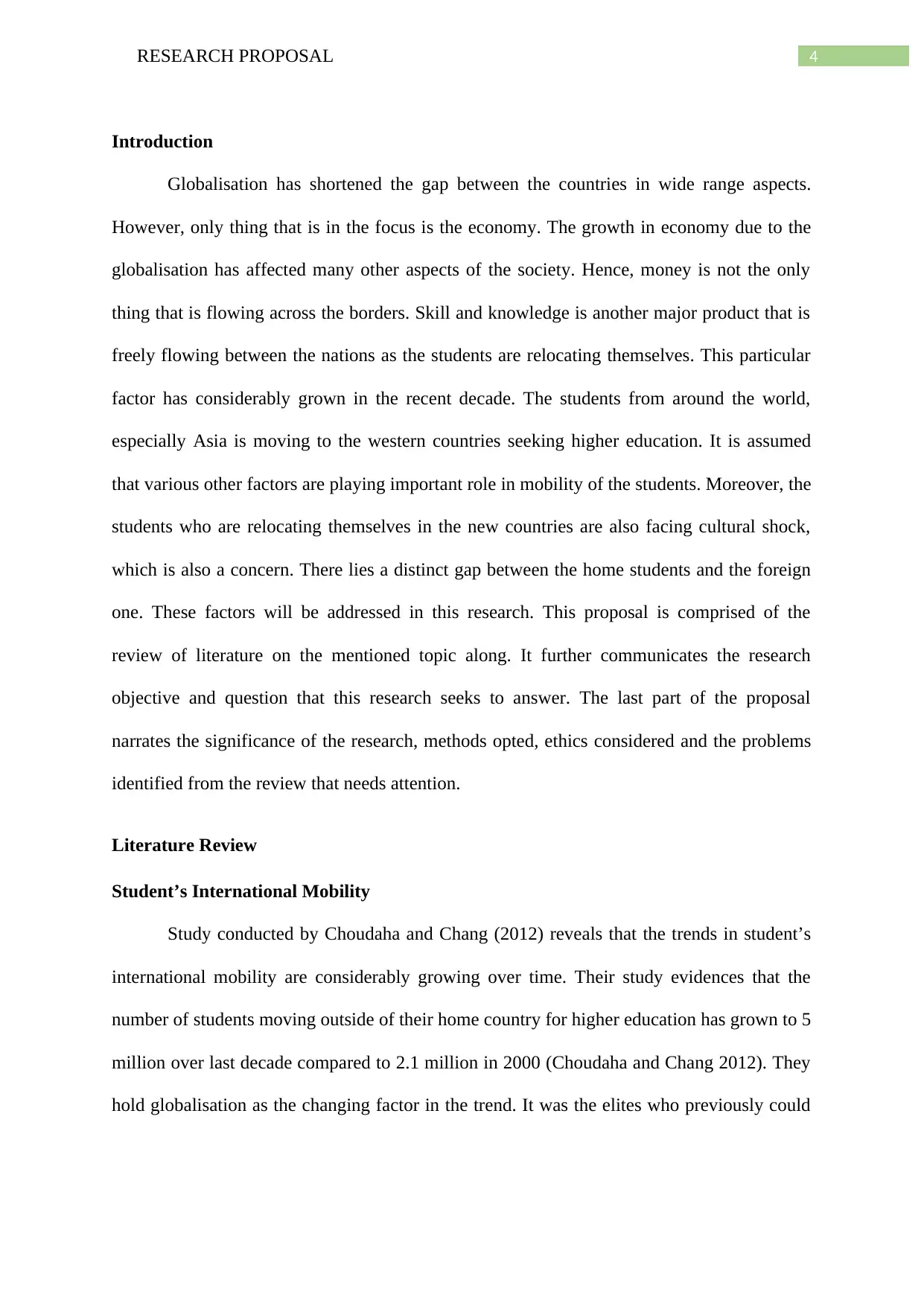
4RESEARCH PROPOSAL
Introduction
Globalisation has shortened the gap between the countries in wide range aspects.
However, only thing that is in the focus is the economy. The growth in economy due to the
globalisation has affected many other aspects of the society. Hence, money is not the only
thing that is flowing across the borders. Skill and knowledge is another major product that is
freely flowing between the nations as the students are relocating themselves. This particular
factor has considerably grown in the recent decade. The students from around the world,
especially Asia is moving to the western countries seeking higher education. It is assumed
that various other factors are playing important role in mobility of the students. Moreover, the
students who are relocating themselves in the new countries are also facing cultural shock,
which is also a concern. There lies a distinct gap between the home students and the foreign
one. These factors will be addressed in this research. This proposal is comprised of the
review of literature on the mentioned topic along. It further communicates the research
objective and question that this research seeks to answer. The last part of the proposal
narrates the significance of the research, methods opted, ethics considered and the problems
identified from the review that needs attention.
Literature Review
Student’s International Mobility
Study conducted by Choudaha and Chang (2012) reveals that the trends in student’s
international mobility are considerably growing over time. Their study evidences that the
number of students moving outside of their home country for higher education has grown to 5
million over last decade compared to 2.1 million in 2000 (Choudaha and Chang 2012). They
hold globalisation as the changing factor in the trend. It was the elites who previously could
Introduction
Globalisation has shortened the gap between the countries in wide range aspects.
However, only thing that is in the focus is the economy. The growth in economy due to the
globalisation has affected many other aspects of the society. Hence, money is not the only
thing that is flowing across the borders. Skill and knowledge is another major product that is
freely flowing between the nations as the students are relocating themselves. This particular
factor has considerably grown in the recent decade. The students from around the world,
especially Asia is moving to the western countries seeking higher education. It is assumed
that various other factors are playing important role in mobility of the students. Moreover, the
students who are relocating themselves in the new countries are also facing cultural shock,
which is also a concern. There lies a distinct gap between the home students and the foreign
one. These factors will be addressed in this research. This proposal is comprised of the
review of literature on the mentioned topic along. It further communicates the research
objective and question that this research seeks to answer. The last part of the proposal
narrates the significance of the research, methods opted, ethics considered and the problems
identified from the review that needs attention.
Literature Review
Student’s International Mobility
Study conducted by Choudaha and Chang (2012) reveals that the trends in student’s
international mobility are considerably growing over time. Their study evidences that the
number of students moving outside of their home country for higher education has grown to 5
million over last decade compared to 2.1 million in 2000 (Choudaha and Chang 2012). They
hold globalisation as the changing factor in the trend. It was the elites who previously could
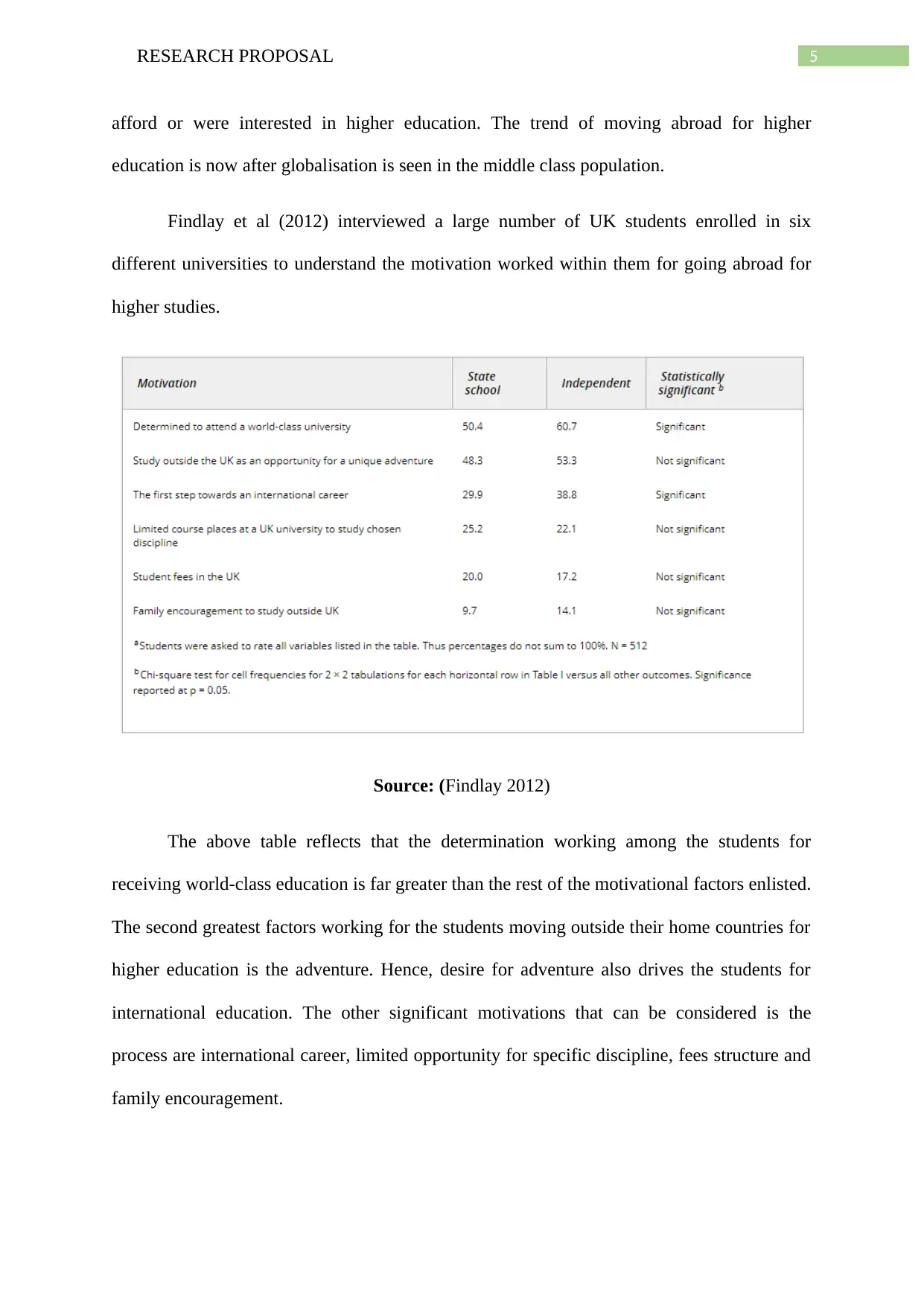
5RESEARCH PROPOSAL
afford or were interested in higher education. The trend of moving abroad for higher
education is now after globalisation is seen in the middle class population.
Findlay et al (2012) interviewed a large number of UK students enrolled in six
different universities to understand the motivation worked within them for going abroad for
higher studies.
Source: (Findlay 2012)
The above table reflects that the determination working among the students for
receiving world-class education is far greater than the rest of the motivational factors enlisted.
The second greatest factors working for the students moving outside their home countries for
higher education is the adventure. Hence, desire for adventure also drives the students for
international education. The other significant motivations that can be considered is the
process are international career, limited opportunity for specific discipline, fees structure and
family encouragement.
afford or were interested in higher education. The trend of moving abroad for higher
education is now after globalisation is seen in the middle class population.
Findlay et al (2012) interviewed a large number of UK students enrolled in six
different universities to understand the motivation worked within them for going abroad for
higher studies.
Source: (Findlay 2012)
The above table reflects that the determination working among the students for
receiving world-class education is far greater than the rest of the motivational factors enlisted.
The second greatest factors working for the students moving outside their home countries for
higher education is the adventure. Hence, desire for adventure also drives the students for
international education. The other significant motivations that can be considered is the
process are international career, limited opportunity for specific discipline, fees structure and
family encouragement.
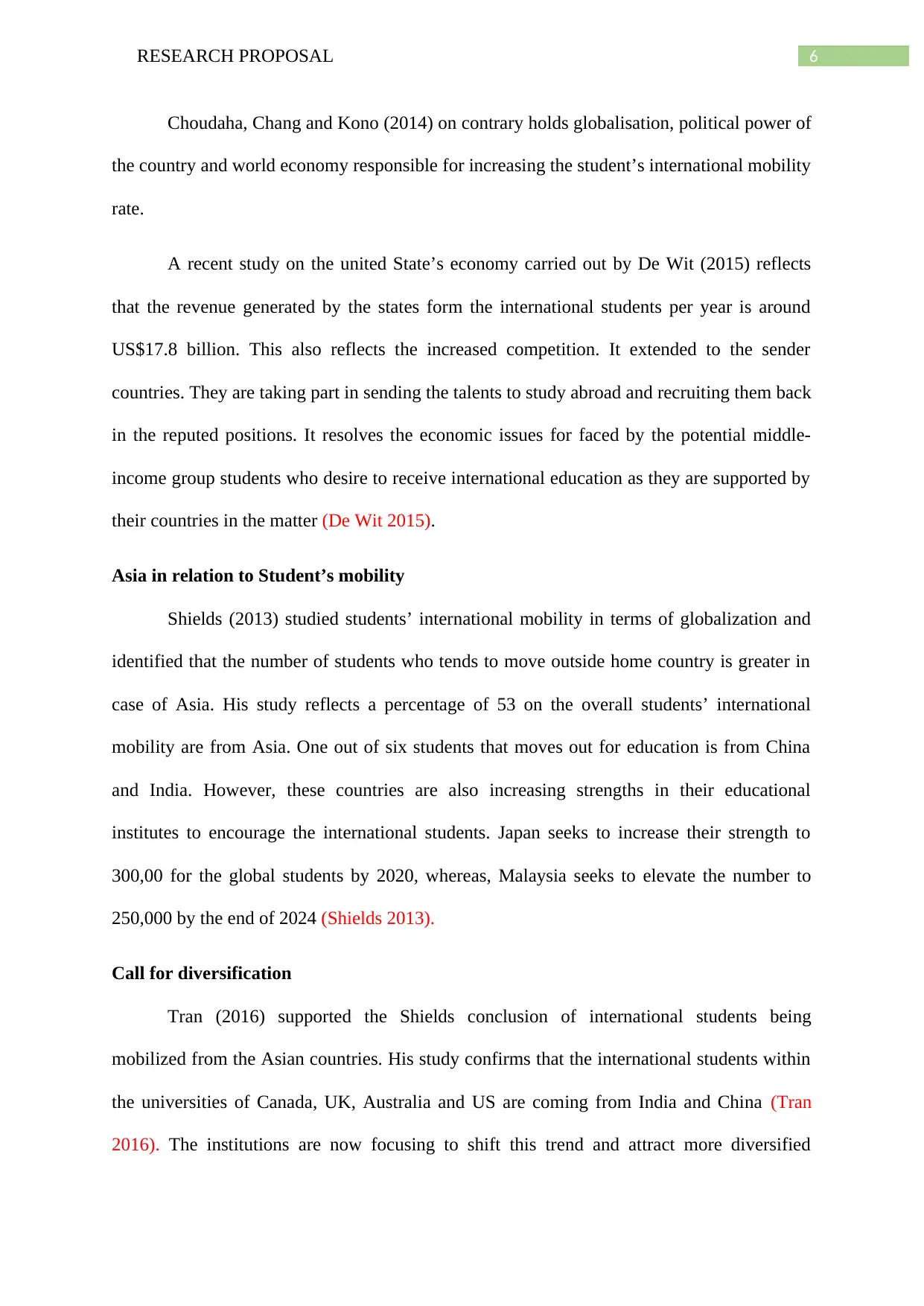
6RESEARCH PROPOSAL
Choudaha, Chang and Kono (2014) on contrary holds globalisation, political power of
the country and world economy responsible for increasing the student’s international mobility
rate.
A recent study on the united State’s economy carried out by De Wit (2015) reflects
that the revenue generated by the states form the international students per year is around
US$17.8 billion. This also reflects the increased competition. It extended to the sender
countries. They are taking part in sending the talents to study abroad and recruiting them back
in the reputed positions. It resolves the economic issues for faced by the potential middle-
income group students who desire to receive international education as they are supported by
their countries in the matter (De Wit 2015).
Asia in relation to Student’s mobility
Shields (2013) studied students’ international mobility in terms of globalization and
identified that the number of students who tends to move outside home country is greater in
case of Asia. His study reflects a percentage of 53 on the overall students’ international
mobility are from Asia. One out of six students that moves out for education is from China
and India. However, these countries are also increasing strengths in their educational
institutes to encourage the international students. Japan seeks to increase their strength to
300,00 for the global students by 2020, whereas, Malaysia seeks to elevate the number to
250,000 by the end of 2024 (Shields 2013).
Call for diversification
Tran (2016) supported the Shields conclusion of international students being
mobilized from the Asian countries. His study confirms that the international students within
the universities of Canada, UK, Australia and US are coming from India and China (Tran
2016). The institutions are now focusing to shift this trend and attract more diversified
Choudaha, Chang and Kono (2014) on contrary holds globalisation, political power of
the country and world economy responsible for increasing the student’s international mobility
rate.
A recent study on the united State’s economy carried out by De Wit (2015) reflects
that the revenue generated by the states form the international students per year is around
US$17.8 billion. This also reflects the increased competition. It extended to the sender
countries. They are taking part in sending the talents to study abroad and recruiting them back
in the reputed positions. It resolves the economic issues for faced by the potential middle-
income group students who desire to receive international education as they are supported by
their countries in the matter (De Wit 2015).
Asia in relation to Student’s mobility
Shields (2013) studied students’ international mobility in terms of globalization and
identified that the number of students who tends to move outside home country is greater in
case of Asia. His study reflects a percentage of 53 on the overall students’ international
mobility are from Asia. One out of six students that moves out for education is from China
and India. However, these countries are also increasing strengths in their educational
institutes to encourage the international students. Japan seeks to increase their strength to
300,00 for the global students by 2020, whereas, Malaysia seeks to elevate the number to
250,000 by the end of 2024 (Shields 2013).
Call for diversification
Tran (2016) supported the Shields conclusion of international students being
mobilized from the Asian countries. His study confirms that the international students within
the universities of Canada, UK, Australia and US are coming from India and China (Tran
2016). The institutions are now focusing to shift this trend and attract more diversified
Paraphrase This Document
Need a fresh take? Get an instant paraphrase of this document with our AI Paraphraser

7RESEARCH PROPOSAL
audience. This diversification is required for stabilizing the sources. It is a backup plan for
ensuring the enrolment of international students in their institutes. It also facilitates in
increasing the quality of their education, as a diversified students’ group will enrich the
institution with diversified culture.
Wei (2013) on the other hand various determinants that makes a country attractive for
the international students. According to his work “An empirical study on the determinants of
international student mobility: a global perspective”, the attraction works separately for the
developing and developed countries. As per Wei’s work, the international students of
developing countries consider both the educational and economic opportunities before
selecting a country potential education destination. The developed countries on the other
hand only seek the educational standards of the hosting countries for selecting it as
destination country. González, Mesanza and Mariel (2011) explain the functional perspective
of these determinants. It is due to the factors that the students from the developing countries
seek job security in the host countries. Whereas, the international students from the
developed countries only seek quality education in their destination country as there is ample
amount of job opportunity in their home country (Hitchcock 2012).
Issues Faced by International Students
Diversified issues have been identified due to the mobility of the students out of their
home country. The first issue as identified by De Wit (2015) is the dissimilarities faced by the
international students in the foreign grounds. The students not only face these dissimilarities
in their daily lives, but it is present in the educational system itself. The international students
are discriminated within the education system. This process as described by psychologists is
culture shock, acculturation and intercultural modification (De Wit 2015).
audience. This diversification is required for stabilizing the sources. It is a backup plan for
ensuring the enrolment of international students in their institutes. It also facilitates in
increasing the quality of their education, as a diversified students’ group will enrich the
institution with diversified culture.
Wei (2013) on the other hand various determinants that makes a country attractive for
the international students. According to his work “An empirical study on the determinants of
international student mobility: a global perspective”, the attraction works separately for the
developing and developed countries. As per Wei’s work, the international students of
developing countries consider both the educational and economic opportunities before
selecting a country potential education destination. The developed countries on the other
hand only seek the educational standards of the hosting countries for selecting it as
destination country. González, Mesanza and Mariel (2011) explain the functional perspective
of these determinants. It is due to the factors that the students from the developing countries
seek job security in the host countries. Whereas, the international students from the
developed countries only seek quality education in their destination country as there is ample
amount of job opportunity in their home country (Hitchcock 2012).
Issues Faced by International Students
Diversified issues have been identified due to the mobility of the students out of their
home country. The first issue as identified by De Wit (2015) is the dissimilarities faced by the
international students in the foreign grounds. The students not only face these dissimilarities
in their daily lives, but it is present in the educational system itself. The international students
are discriminated within the education system. This process as described by psychologists is
culture shock, acculturation and intercultural modification (De Wit 2015).
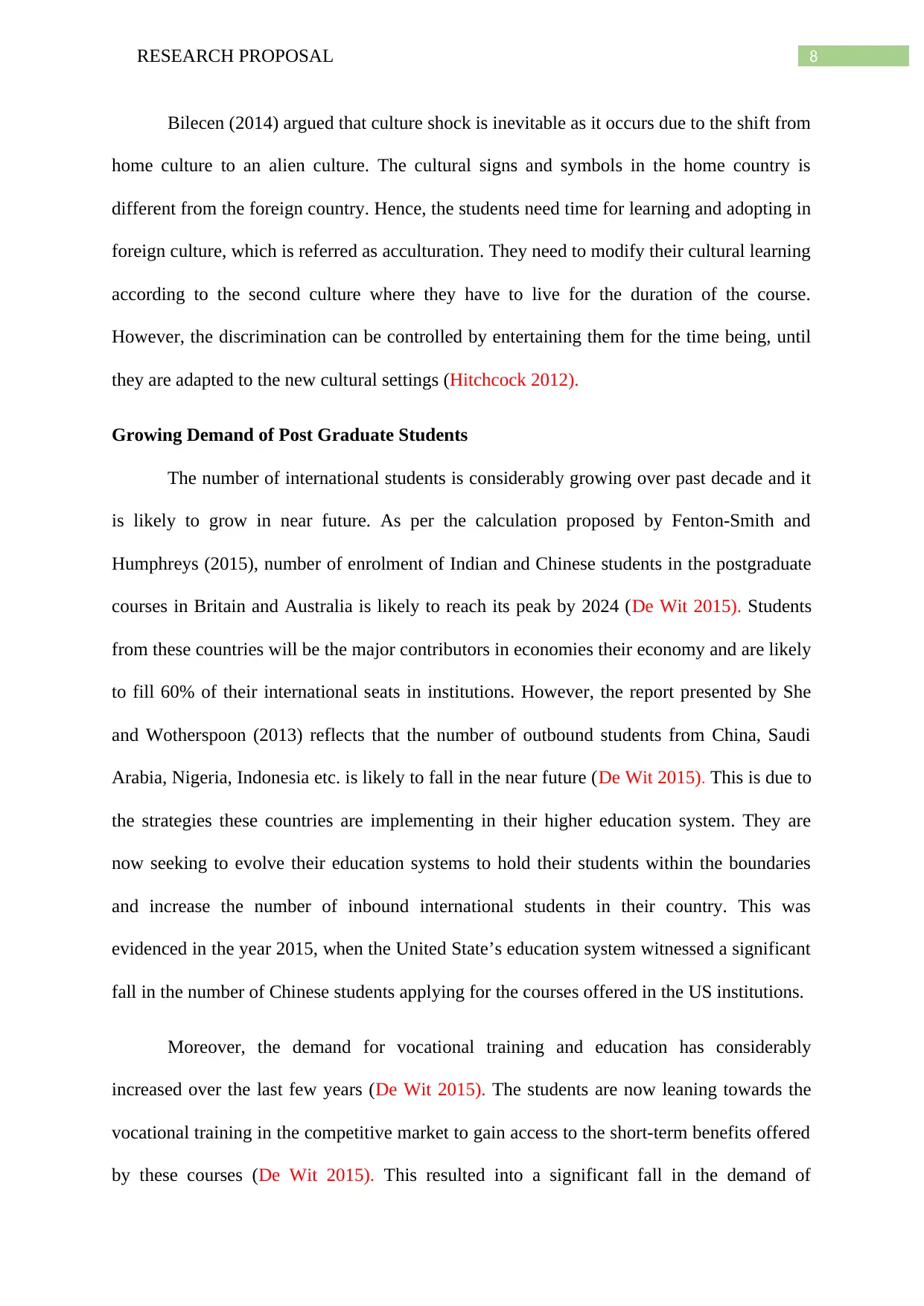
8RESEARCH PROPOSAL
Bilecen (2014) argued that culture shock is inevitable as it occurs due to the shift from
home culture to an alien culture. The cultural signs and symbols in the home country is
different from the foreign country. Hence, the students need time for learning and adopting in
foreign culture, which is referred as acculturation. They need to modify their cultural learning
according to the second culture where they have to live for the duration of the course.
However, the discrimination can be controlled by entertaining them for the time being, until
they are adapted to the new cultural settings (Hitchcock 2012).
Growing Demand of Post Graduate Students
The number of international students is considerably growing over past decade and it
is likely to grow in near future. As per the calculation proposed by Fenton-Smith and
Humphreys (2015), number of enrolment of Indian and Chinese students in the postgraduate
courses in Britain and Australia is likely to reach its peak by 2024 (De Wit 2015). Students
from these countries will be the major contributors in economies their economy and are likely
to fill 60% of their international seats in institutions. However, the report presented by She
and Wotherspoon (2013) reflects that the number of outbound students from China, Saudi
Arabia, Nigeria, Indonesia etc. is likely to fall in the near future (De Wit 2015). This is due to
the strategies these countries are implementing in their higher education system. They are
now seeking to evolve their education systems to hold their students within the boundaries
and increase the number of inbound international students in their country. This was
evidenced in the year 2015, when the United State’s education system witnessed a significant
fall in the number of Chinese students applying for the courses offered in the US institutions.
Moreover, the demand for vocational training and education has considerably
increased over the last few years (De Wit 2015). The students are now leaning towards the
vocational training in the competitive market to gain access to the short-term benefits offered
by these courses (De Wit 2015). This resulted into a significant fall in the demand of
Bilecen (2014) argued that culture shock is inevitable as it occurs due to the shift from
home culture to an alien culture. The cultural signs and symbols in the home country is
different from the foreign country. Hence, the students need time for learning and adopting in
foreign culture, which is referred as acculturation. They need to modify their cultural learning
according to the second culture where they have to live for the duration of the course.
However, the discrimination can be controlled by entertaining them for the time being, until
they are adapted to the new cultural settings (Hitchcock 2012).
Growing Demand of Post Graduate Students
The number of international students is considerably growing over past decade and it
is likely to grow in near future. As per the calculation proposed by Fenton-Smith and
Humphreys (2015), number of enrolment of Indian and Chinese students in the postgraduate
courses in Britain and Australia is likely to reach its peak by 2024 (De Wit 2015). Students
from these countries will be the major contributors in economies their economy and are likely
to fill 60% of their international seats in institutions. However, the report presented by She
and Wotherspoon (2013) reflects that the number of outbound students from China, Saudi
Arabia, Nigeria, Indonesia etc. is likely to fall in the near future (De Wit 2015). This is due to
the strategies these countries are implementing in their higher education system. They are
now seeking to evolve their education systems to hold their students within the boundaries
and increase the number of inbound international students in their country. This was
evidenced in the year 2015, when the United State’s education system witnessed a significant
fall in the number of Chinese students applying for the courses offered in the US institutions.
Moreover, the demand for vocational training and education has considerably
increased over the last few years (De Wit 2015). The students are now leaning towards the
vocational training in the competitive market to gain access to the short-term benefits offered
by these courses (De Wit 2015). This resulted into a significant fall in the demand of
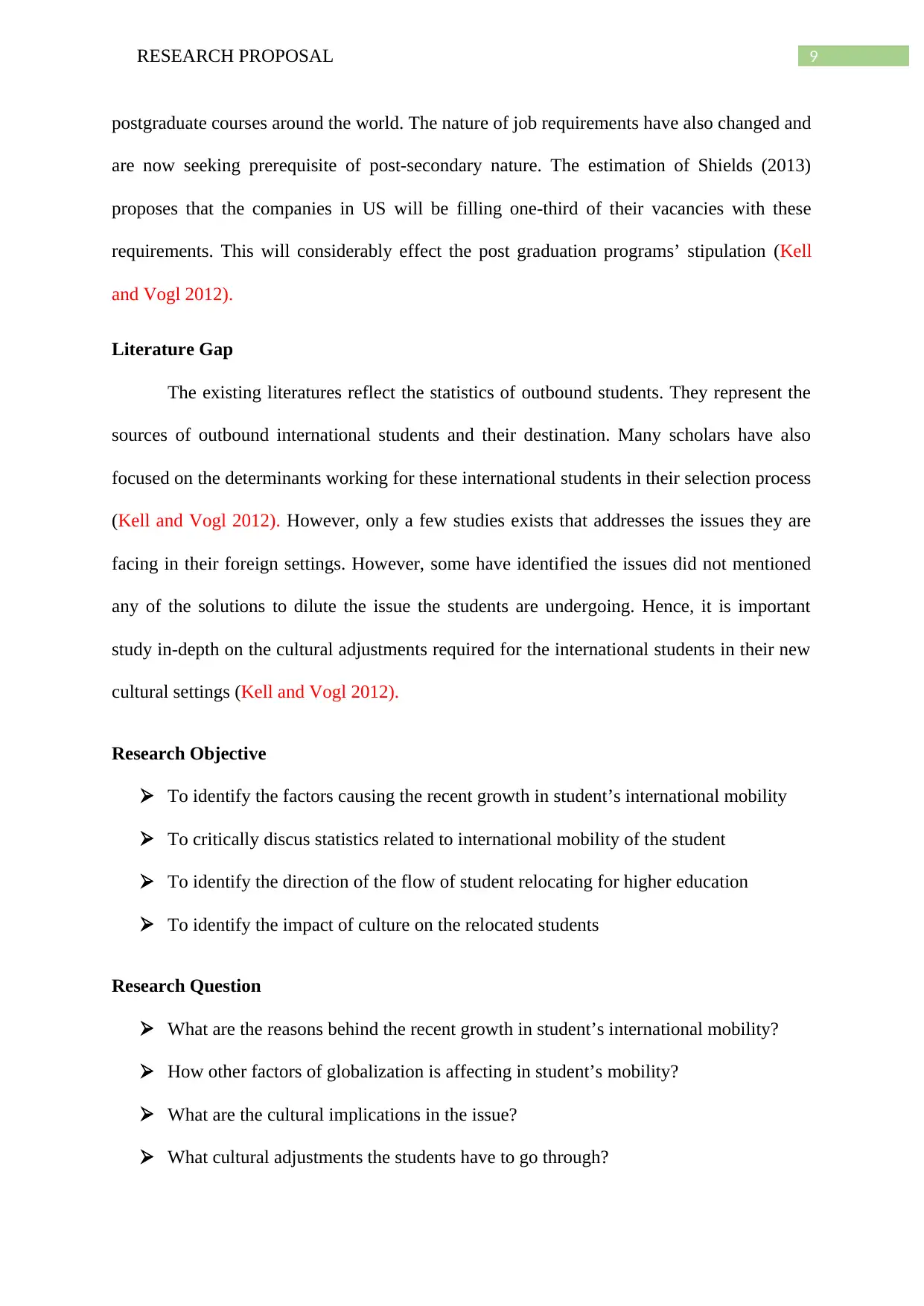
9RESEARCH PROPOSAL
postgraduate courses around the world. The nature of job requirements have also changed and
are now seeking prerequisite of post-secondary nature. The estimation of Shields (2013)
proposes that the companies in US will be filling one-third of their vacancies with these
requirements. This will considerably effect the post graduation programs’ stipulation (Kell
and Vogl 2012).
Literature Gap
The existing literatures reflect the statistics of outbound students. They represent the
sources of outbound international students and their destination. Many scholars have also
focused on the determinants working for these international students in their selection process
(Kell and Vogl 2012). However, only a few studies exists that addresses the issues they are
facing in their foreign settings. However, some have identified the issues did not mentioned
any of the solutions to dilute the issue the students are undergoing. Hence, it is important
study in-depth on the cultural adjustments required for the international students in their new
cultural settings (Kell and Vogl 2012).
Research Objective
To identify the factors causing the recent growth in student’s international mobility
To critically discus statistics related to international mobility of the student
To identify the direction of the flow of student relocating for higher education
To identify the impact of culture on the relocated students
Research Question
What are the reasons behind the recent growth in student’s international mobility?
How other factors of globalization is affecting in student’s mobility?
What are the cultural implications in the issue?
What cultural adjustments the students have to go through?
postgraduate courses around the world. The nature of job requirements have also changed and
are now seeking prerequisite of post-secondary nature. The estimation of Shields (2013)
proposes that the companies in US will be filling one-third of their vacancies with these
requirements. This will considerably effect the post graduation programs’ stipulation (Kell
and Vogl 2012).
Literature Gap
The existing literatures reflect the statistics of outbound students. They represent the
sources of outbound international students and their destination. Many scholars have also
focused on the determinants working for these international students in their selection process
(Kell and Vogl 2012). However, only a few studies exists that addresses the issues they are
facing in their foreign settings. However, some have identified the issues did not mentioned
any of the solutions to dilute the issue the students are undergoing. Hence, it is important
study in-depth on the cultural adjustments required for the international students in their new
cultural settings (Kell and Vogl 2012).
Research Objective
To identify the factors causing the recent growth in student’s international mobility
To critically discus statistics related to international mobility of the student
To identify the direction of the flow of student relocating for higher education
To identify the impact of culture on the relocated students
Research Question
What are the reasons behind the recent growth in student’s international mobility?
How other factors of globalization is affecting in student’s mobility?
What are the cultural implications in the issue?
What cultural adjustments the students have to go through?
Secure Best Marks with AI Grader
Need help grading? Try our AI Grader for instant feedback on your assignments.
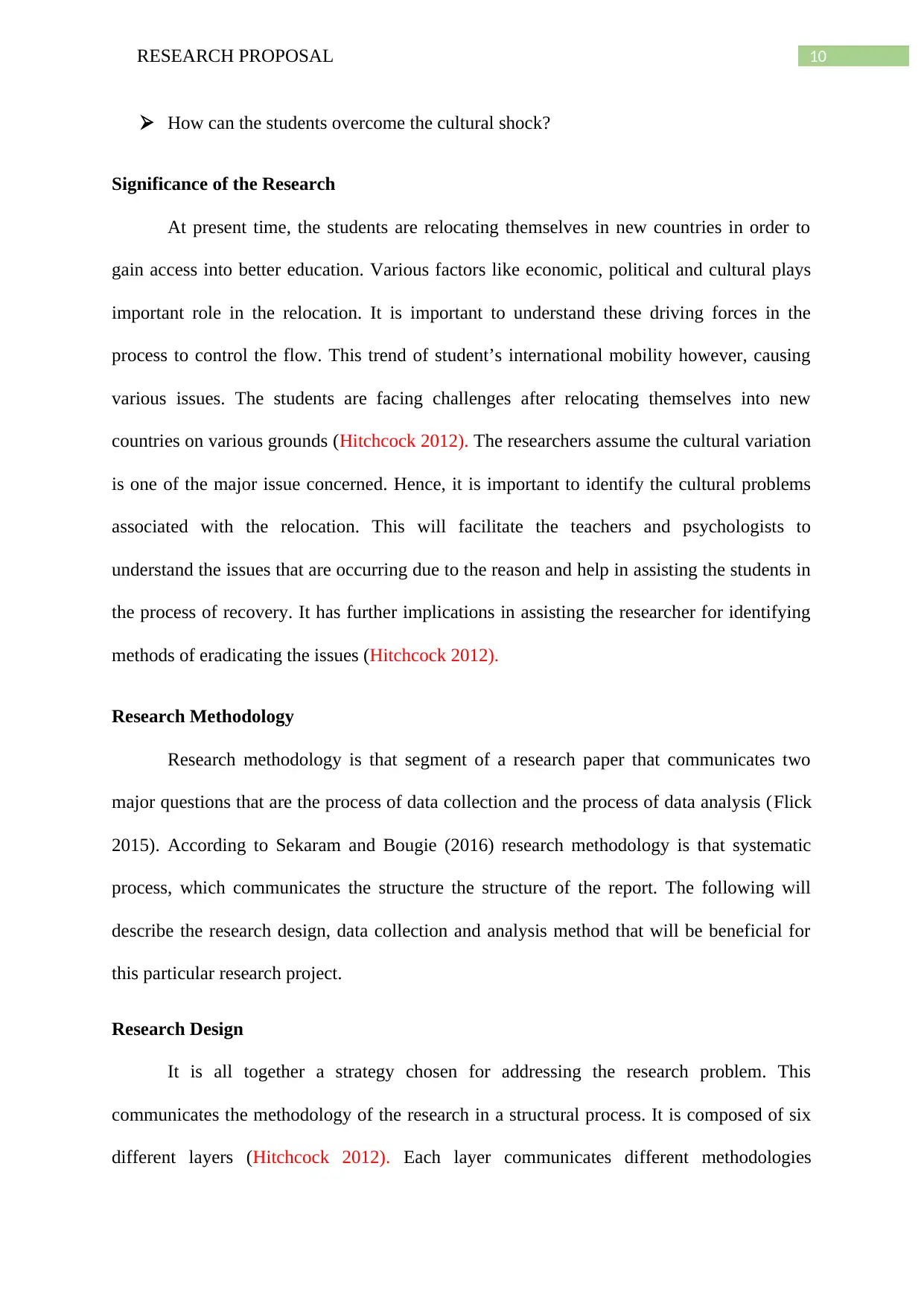
10RESEARCH PROPOSAL
How can the students overcome the cultural shock?
Significance of the Research
At present time, the students are relocating themselves in new countries in order to
gain access into better education. Various factors like economic, political and cultural plays
important role in the relocation. It is important to understand these driving forces in the
process to control the flow. This trend of student’s international mobility however, causing
various issues. The students are facing challenges after relocating themselves into new
countries on various grounds (Hitchcock 2012). The researchers assume the cultural variation
is one of the major issue concerned. Hence, it is important to identify the cultural problems
associated with the relocation. This will facilitate the teachers and psychologists to
understand the issues that are occurring due to the reason and help in assisting the students in
the process of recovery. It has further implications in assisting the researcher for identifying
methods of eradicating the issues (Hitchcock 2012).
Research Methodology
Research methodology is that segment of a research paper that communicates two
major questions that are the process of data collection and the process of data analysis (Flick
2015). According to Sekaram and Bougie (2016) research methodology is that systematic
process, which communicates the structure the structure of the report. The following will
describe the research design, data collection and analysis method that will be beneficial for
this particular research project.
Research Design
It is all together a strategy chosen for addressing the research problem. This
communicates the methodology of the research in a structural process. It is composed of six
different layers (Hitchcock 2012). Each layer communicates different methodologies
How can the students overcome the cultural shock?
Significance of the Research
At present time, the students are relocating themselves in new countries in order to
gain access into better education. Various factors like economic, political and cultural plays
important role in the relocation. It is important to understand these driving forces in the
process to control the flow. This trend of student’s international mobility however, causing
various issues. The students are facing challenges after relocating themselves into new
countries on various grounds (Hitchcock 2012). The researchers assume the cultural variation
is one of the major issue concerned. Hence, it is important to identify the cultural problems
associated with the relocation. This will facilitate the teachers and psychologists to
understand the issues that are occurring due to the reason and help in assisting the students in
the process of recovery. It has further implications in assisting the researcher for identifying
methods of eradicating the issues (Hitchcock 2012).
Research Methodology
Research methodology is that segment of a research paper that communicates two
major questions that are the process of data collection and the process of data analysis (Flick
2015). According to Sekaram and Bougie (2016) research methodology is that systematic
process, which communicates the structure the structure of the report. The following will
describe the research design, data collection and analysis method that will be beneficial for
this particular research project.
Research Design
It is all together a strategy chosen for addressing the research problem. This
communicates the methodology of the research in a structural process. It is composed of six
different layers (Hitchcock 2012). Each layer communicates different methodologies
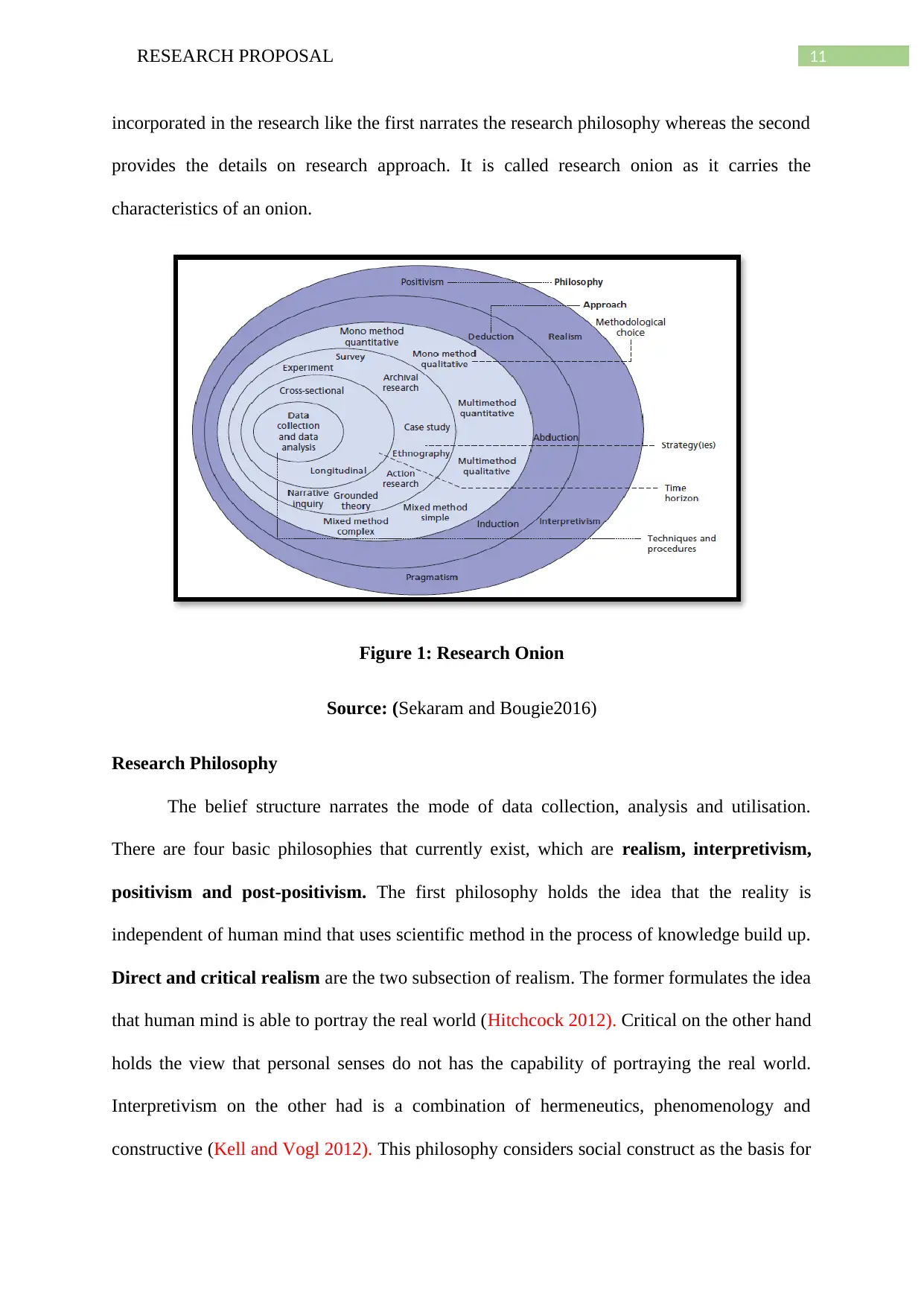
11RESEARCH PROPOSAL
incorporated in the research like the first narrates the research philosophy whereas the second
provides the details on research approach. It is called research onion as it carries the
characteristics of an onion.
Figure 1: Research Onion
Source: (Sekaram and Bougie2016)
Research Philosophy
The belief structure narrates the mode of data collection, analysis and utilisation.
There are four basic philosophies that currently exist, which are realism, interpretivism,
positivism and post-positivism. The first philosophy holds the idea that the reality is
independent of human mind that uses scientific method in the process of knowledge build up.
Direct and critical realism are the two subsection of realism. The former formulates the idea
that human mind is able to portray the real world (Hitchcock 2012). Critical on the other hand
holds the view that personal senses do not has the capability of portraying the real world.
Interpretivism on the other had is a combination of hermeneutics, phenomenology and
constructive (Kell and Vogl 2012). This philosophy considers social construct as the basis for
incorporated in the research like the first narrates the research philosophy whereas the second
provides the details on research approach. It is called research onion as it carries the
characteristics of an onion.
Figure 1: Research Onion
Source: (Sekaram and Bougie2016)
Research Philosophy
The belief structure narrates the mode of data collection, analysis and utilisation.
There are four basic philosophies that currently exist, which are realism, interpretivism,
positivism and post-positivism. The first philosophy holds the idea that the reality is
independent of human mind that uses scientific method in the process of knowledge build up.
Direct and critical realism are the two subsection of realism. The former formulates the idea
that human mind is able to portray the real world (Hitchcock 2012). Critical on the other hand
holds the view that personal senses do not has the capability of portraying the real world.
Interpretivism on the other had is a combination of hermeneutics, phenomenology and
constructive (Kell and Vogl 2012). This philosophy considers social construct as the basis for
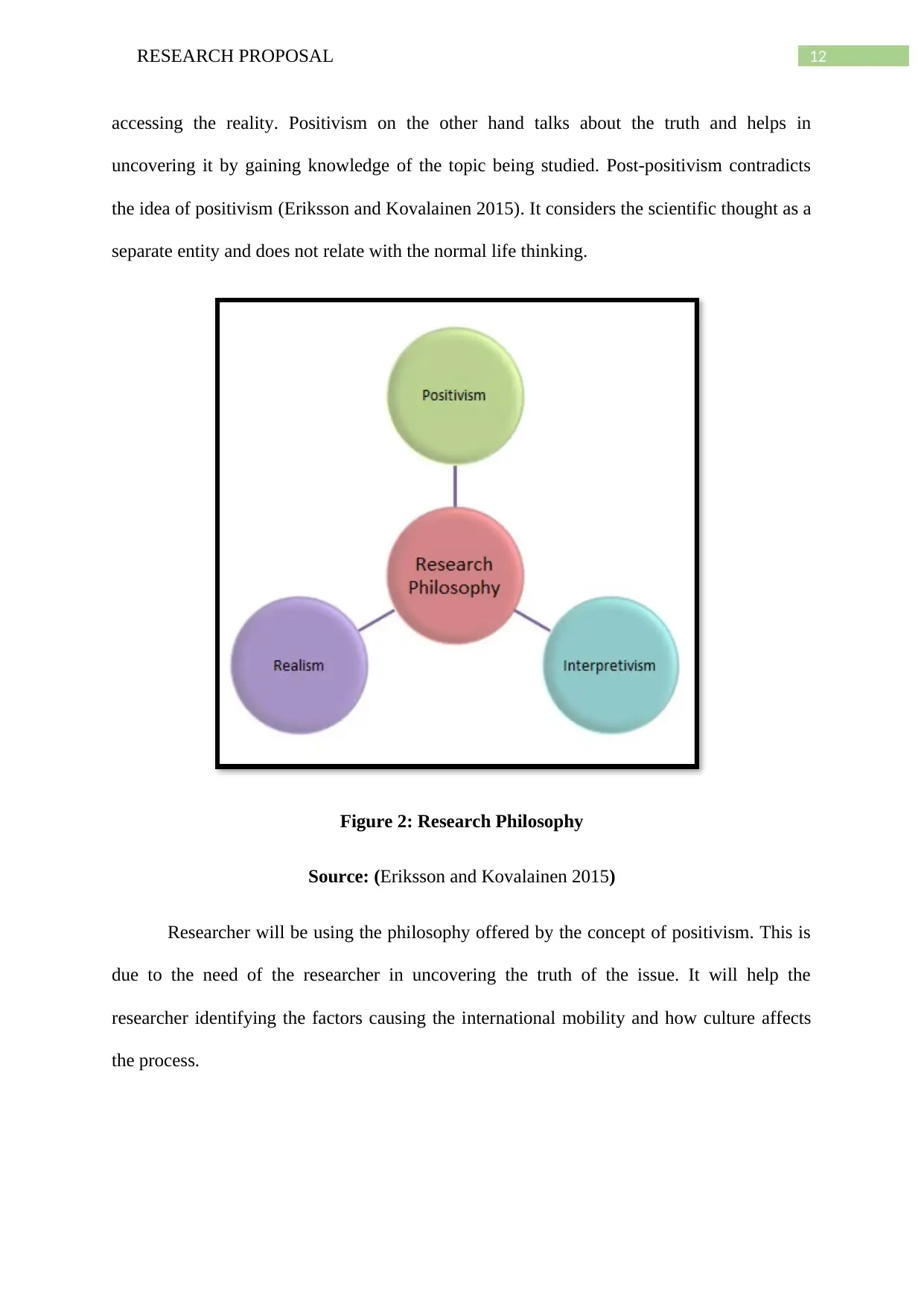
12RESEARCH PROPOSAL
accessing the reality. Positivism on the other hand talks about the truth and helps in
uncovering it by gaining knowledge of the topic being studied. Post-positivism contradicts
the idea of positivism (Eriksson and Kovalainen 2015). It considers the scientific thought as a
separate entity and does not relate with the normal life thinking.
Figure 2: Research Philosophy
Source: (Eriksson and Kovalainen 2015)
Researcher will be using the philosophy offered by the concept of positivism. This is
due to the need of the researcher in uncovering the truth of the issue. It will help the
researcher identifying the factors causing the international mobility and how culture affects
the process.
accessing the reality. Positivism on the other hand talks about the truth and helps in
uncovering it by gaining knowledge of the topic being studied. Post-positivism contradicts
the idea of positivism (Eriksson and Kovalainen 2015). It considers the scientific thought as a
separate entity and does not relate with the normal life thinking.
Figure 2: Research Philosophy
Source: (Eriksson and Kovalainen 2015)
Researcher will be using the philosophy offered by the concept of positivism. This is
due to the need of the researcher in uncovering the truth of the issue. It will help the
researcher identifying the factors causing the international mobility and how culture affects
the process.
Paraphrase This Document
Need a fresh take? Get an instant paraphrase of this document with our AI Paraphraser

13RESEARCH PROPOSAL
Research Approach
Deductive and inductive approaches are the two approaches a researcher can adopt.
The first one helps in validating the existing theories, whereas, the second helps the
researcher in introducing altogether a new theory (Waltmanet al. 2012). The deductive
approach will be beneficial as this particular research seeks to identify causes of the issue of
the students while they are shifting from one country to another for educational purposes.
Figure 6: Research Approach
Source: (Waltmanet al. 2012)
Data Collection and Data Analysis
A researcher can use either primary or secondary or both the methods of data
collection for a single research. Both the methods in this case show potential benefits. The
data can be collected using two basic methods that are qualitative and qualitative data
collection (Hitchcock 2012). The former involves interview schedules and open ended
Research Approach
Deductive and inductive approaches are the two approaches a researcher can adopt.
The first one helps in validating the existing theories, whereas, the second helps the
researcher in introducing altogether a new theory (Waltmanet al. 2012). The deductive
approach will be beneficial as this particular research seeks to identify causes of the issue of
the students while they are shifting from one country to another for educational purposes.
Figure 6: Research Approach
Source: (Waltmanet al. 2012)
Data Collection and Data Analysis
A researcher can use either primary or secondary or both the methods of data
collection for a single research. Both the methods in this case show potential benefits. The
data can be collected using two basic methods that are qualitative and qualitative data
collection (Hitchcock 2012). The former involves interview schedules and open ended

14RESEARCH PROPOSAL
question that will be implemented in this case. It is important to gather this unquantifiable
data to understand the situation the students are experiencing. This method can be
implemented on the students, as they are the primary stakeholders of this research (Payne and
Dorn 2013). Focused group interview in this case is selected as this has the potential to
provide cumulative experience of the students. Whereas, the quantitative method that are
proposed to implement involves surveys and questionnaires for collect the quantifiable data.
It is possible for the researcher to implement these methods either independently or all
together. If any particular method is independently implemented for the sake of data
collection, it is called mono method. Mixed method on the other hand refers to the use of
multiple methods for extracting data from the respondents (Palinkaset al. 2015). Multiple
similar methods used for extracting qualitative data are called multi method qualitative. Same
goes for the extraction of quantitative data. Moreover, use of both qualitative and quantitative
method is referred as multi method complex. This study will be requiring a mixed method
for data collection (Hitchcock 2012).
For the analysis of the collected data, researcher requires to incorporate a range of
analytical tool. Thematic analysis method will be incorporated in this case to identify the
pattern in the answers received from the respondents in order to analyse the qualitative data
(Miles, Huberman and Saldana 2013). The data collected will be categorised under various
themes and analysed accordingly for understanding the source of the issue. Quantitative data
analysis on the other hand involves the interpretation of data received form closed ended
questionnaire. The researcher needs different graphs and tools for analysing the quantitative
data (Treiman 2014). The data should be put in those graphs and charts to receive results that
will later be assumed for reaching a particular conclusion. The dependent and independent
variables are then put into the regression tool for analysing. Furthermore, Pearson’s
regression correlation tool will be used in this research, as tool will facilitate in identification
question that will be implemented in this case. It is important to gather this unquantifiable
data to understand the situation the students are experiencing. This method can be
implemented on the students, as they are the primary stakeholders of this research (Payne and
Dorn 2013). Focused group interview in this case is selected as this has the potential to
provide cumulative experience of the students. Whereas, the quantitative method that are
proposed to implement involves surveys and questionnaires for collect the quantifiable data.
It is possible for the researcher to implement these methods either independently or all
together. If any particular method is independently implemented for the sake of data
collection, it is called mono method. Mixed method on the other hand refers to the use of
multiple methods for extracting data from the respondents (Palinkaset al. 2015). Multiple
similar methods used for extracting qualitative data are called multi method qualitative. Same
goes for the extraction of quantitative data. Moreover, use of both qualitative and quantitative
method is referred as multi method complex. This study will be requiring a mixed method
for data collection (Hitchcock 2012).
For the analysis of the collected data, researcher requires to incorporate a range of
analytical tool. Thematic analysis method will be incorporated in this case to identify the
pattern in the answers received from the respondents in order to analyse the qualitative data
(Miles, Huberman and Saldana 2013). The data collected will be categorised under various
themes and analysed accordingly for understanding the source of the issue. Quantitative data
analysis on the other hand involves the interpretation of data received form closed ended
questionnaire. The researcher needs different graphs and tools for analysing the quantitative
data (Treiman 2014). The data should be put in those graphs and charts to receive results that
will later be assumed for reaching a particular conclusion. The dependent and independent
variables are then put into the regression tool for analysing. Furthermore, Pearson’s
regression correlation tool will be used in this research, as tool will facilitate in identification
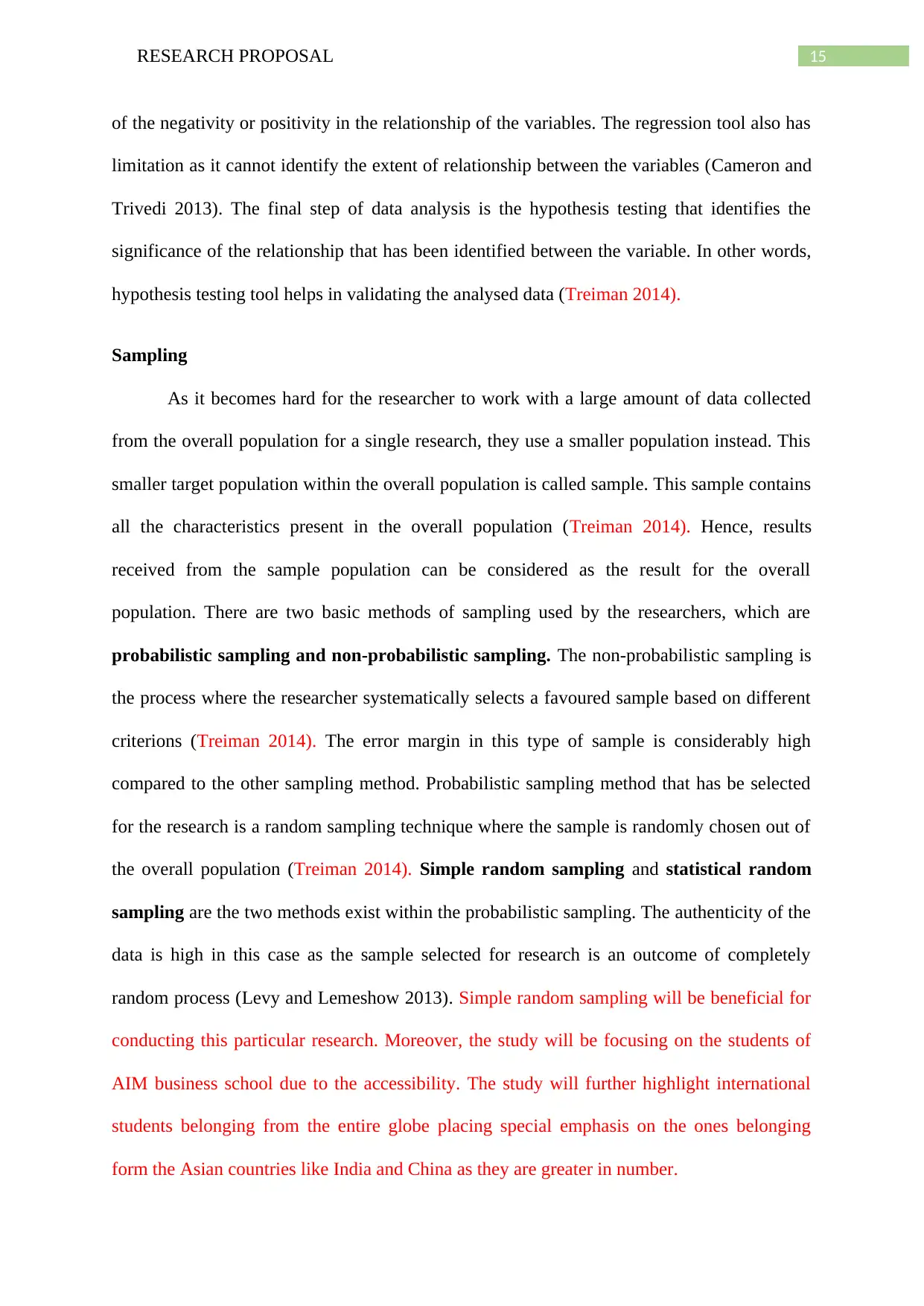
15RESEARCH PROPOSAL
of the negativity or positivity in the relationship of the variables. The regression tool also has
limitation as it cannot identify the extent of relationship between the variables (Cameron and
Trivedi 2013). The final step of data analysis is the hypothesis testing that identifies the
significance of the relationship that has been identified between the variable. In other words,
hypothesis testing tool helps in validating the analysed data (Treiman 2014).
Sampling
As it becomes hard for the researcher to work with a large amount of data collected
from the overall population for a single research, they use a smaller population instead. This
smaller target population within the overall population is called sample. This sample contains
all the characteristics present in the overall population (Treiman 2014). Hence, results
received from the sample population can be considered as the result for the overall
population. There are two basic methods of sampling used by the researchers, which are
probabilistic sampling and non-probabilistic sampling. The non-probabilistic sampling is
the process where the researcher systematically selects a favoured sample based on different
criterions (Treiman 2014). The error margin in this type of sample is considerably high
compared to the other sampling method. Probabilistic sampling method that has be selected
for the research is a random sampling technique where the sample is randomly chosen out of
the overall population (Treiman 2014). Simple random sampling and statistical random
sampling are the two methods exist within the probabilistic sampling. The authenticity of the
data is high in this case as the sample selected for research is an outcome of completely
random process (Levy and Lemeshow 2013). Simple random sampling will be beneficial for
conducting this particular research. Moreover, the study will be focusing on the students of
AIM business school due to the accessibility. The study will further highlight international
students belonging from the entire globe placing special emphasis on the ones belonging
form the Asian countries like India and China as they are greater in number.
of the negativity or positivity in the relationship of the variables. The regression tool also has
limitation as it cannot identify the extent of relationship between the variables (Cameron and
Trivedi 2013). The final step of data analysis is the hypothesis testing that identifies the
significance of the relationship that has been identified between the variable. In other words,
hypothesis testing tool helps in validating the analysed data (Treiman 2014).
Sampling
As it becomes hard for the researcher to work with a large amount of data collected
from the overall population for a single research, they use a smaller population instead. This
smaller target population within the overall population is called sample. This sample contains
all the characteristics present in the overall population (Treiman 2014). Hence, results
received from the sample population can be considered as the result for the overall
population. There are two basic methods of sampling used by the researchers, which are
probabilistic sampling and non-probabilistic sampling. The non-probabilistic sampling is
the process where the researcher systematically selects a favoured sample based on different
criterions (Treiman 2014). The error margin in this type of sample is considerably high
compared to the other sampling method. Probabilistic sampling method that has be selected
for the research is a random sampling technique where the sample is randomly chosen out of
the overall population (Treiman 2014). Simple random sampling and statistical random
sampling are the two methods exist within the probabilistic sampling. The authenticity of the
data is high in this case as the sample selected for research is an outcome of completely
random process (Levy and Lemeshow 2013). Simple random sampling will be beneficial for
conducting this particular research. Moreover, the study will be focusing on the students of
AIM business school due to the accessibility. The study will further highlight international
students belonging from the entire globe placing special emphasis on the ones belonging
form the Asian countries like India and China as they are greater in number.
Secure Best Marks with AI Grader
Need help grading? Try our AI Grader for instant feedback on your assignments.
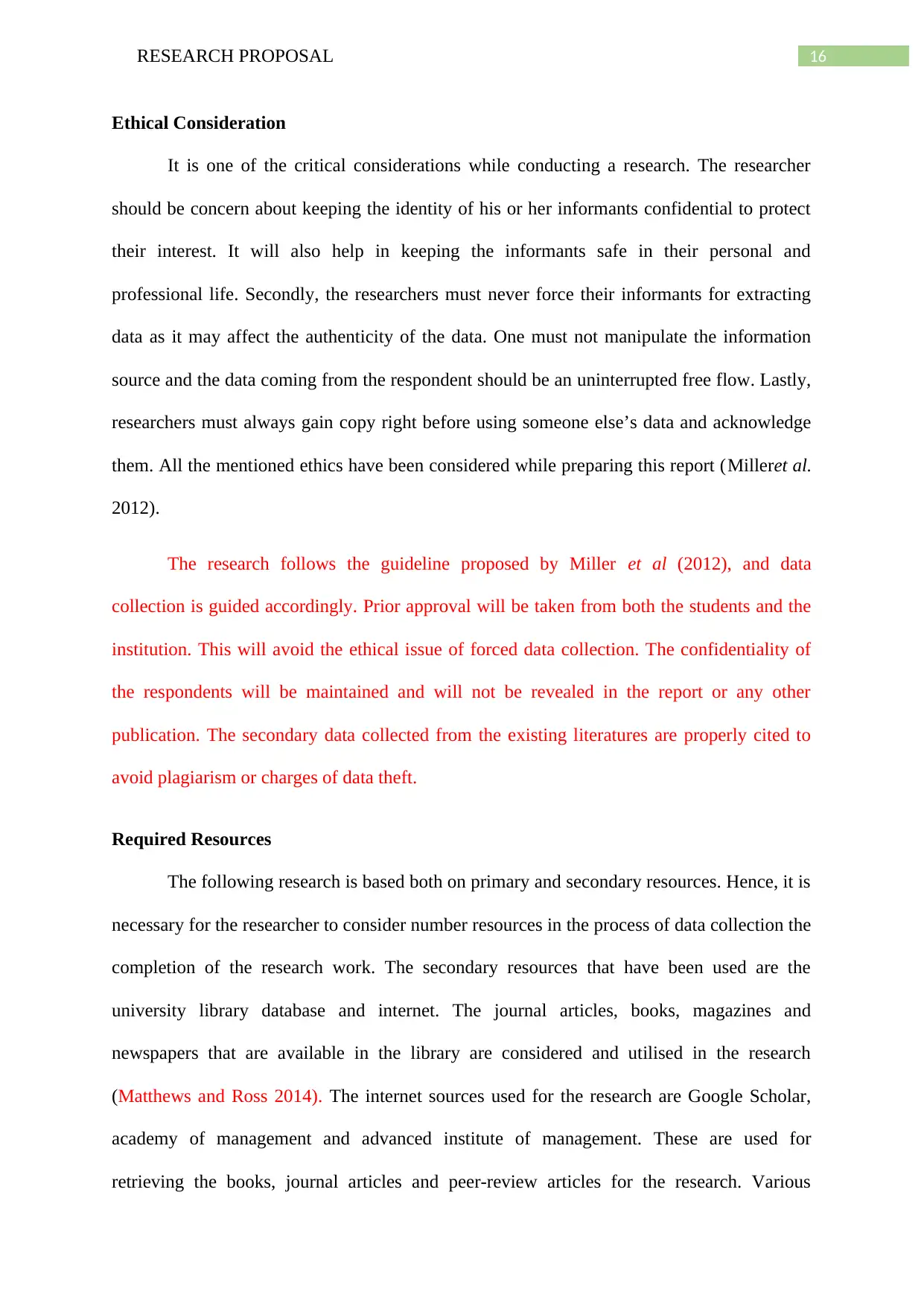
16RESEARCH PROPOSAL
Ethical Consideration
It is one of the critical considerations while conducting a research. The researcher
should be concern about keeping the identity of his or her informants confidential to protect
their interest. It will also help in keeping the informants safe in their personal and
professional life. Secondly, the researchers must never force their informants for extracting
data as it may affect the authenticity of the data. One must not manipulate the information
source and the data coming from the respondent should be an uninterrupted free flow. Lastly,
researchers must always gain copy right before using someone else’s data and acknowledge
them. All the mentioned ethics have been considered while preparing this report (Milleret al.
2012).
The research follows the guideline proposed by Miller et al (2012), and data
collection is guided accordingly. Prior approval will be taken from both the students and the
institution. This will avoid the ethical issue of forced data collection. The confidentiality of
the respondents will be maintained and will not be revealed in the report or any other
publication. The secondary data collected from the existing literatures are properly cited to
avoid plagiarism or charges of data theft.
Required Resources
The following research is based both on primary and secondary resources. Hence, it is
necessary for the researcher to consider number resources in the process of data collection the
completion of the research work. The secondary resources that have been used are the
university library database and internet. The journal articles, books, magazines and
newspapers that are available in the library are considered and utilised in the research
(Matthews and Ross 2014). The internet sources used for the research are Google Scholar,
academy of management and advanced institute of management. These are used for
retrieving the books, journal articles and peer-review articles for the research. Various
Ethical Consideration
It is one of the critical considerations while conducting a research. The researcher
should be concern about keeping the identity of his or her informants confidential to protect
their interest. It will also help in keeping the informants safe in their personal and
professional life. Secondly, the researchers must never force their informants for extracting
data as it may affect the authenticity of the data. One must not manipulate the information
source and the data coming from the respondent should be an uninterrupted free flow. Lastly,
researchers must always gain copy right before using someone else’s data and acknowledge
them. All the mentioned ethics have been considered while preparing this report (Milleret al.
2012).
The research follows the guideline proposed by Miller et al (2012), and data
collection is guided accordingly. Prior approval will be taken from both the students and the
institution. This will avoid the ethical issue of forced data collection. The confidentiality of
the respondents will be maintained and will not be revealed in the report or any other
publication. The secondary data collected from the existing literatures are properly cited to
avoid plagiarism or charges of data theft.
Required Resources
The following research is based both on primary and secondary resources. Hence, it is
necessary for the researcher to consider number resources in the process of data collection the
completion of the research work. The secondary resources that have been used are the
university library database and internet. The journal articles, books, magazines and
newspapers that are available in the library are considered and utilised in the research
(Matthews and Ross 2014). The internet sources used for the research are Google Scholar,
academy of management and advanced institute of management. These are used for
retrieving the books, journal articles and peer-review articles for the research. Various
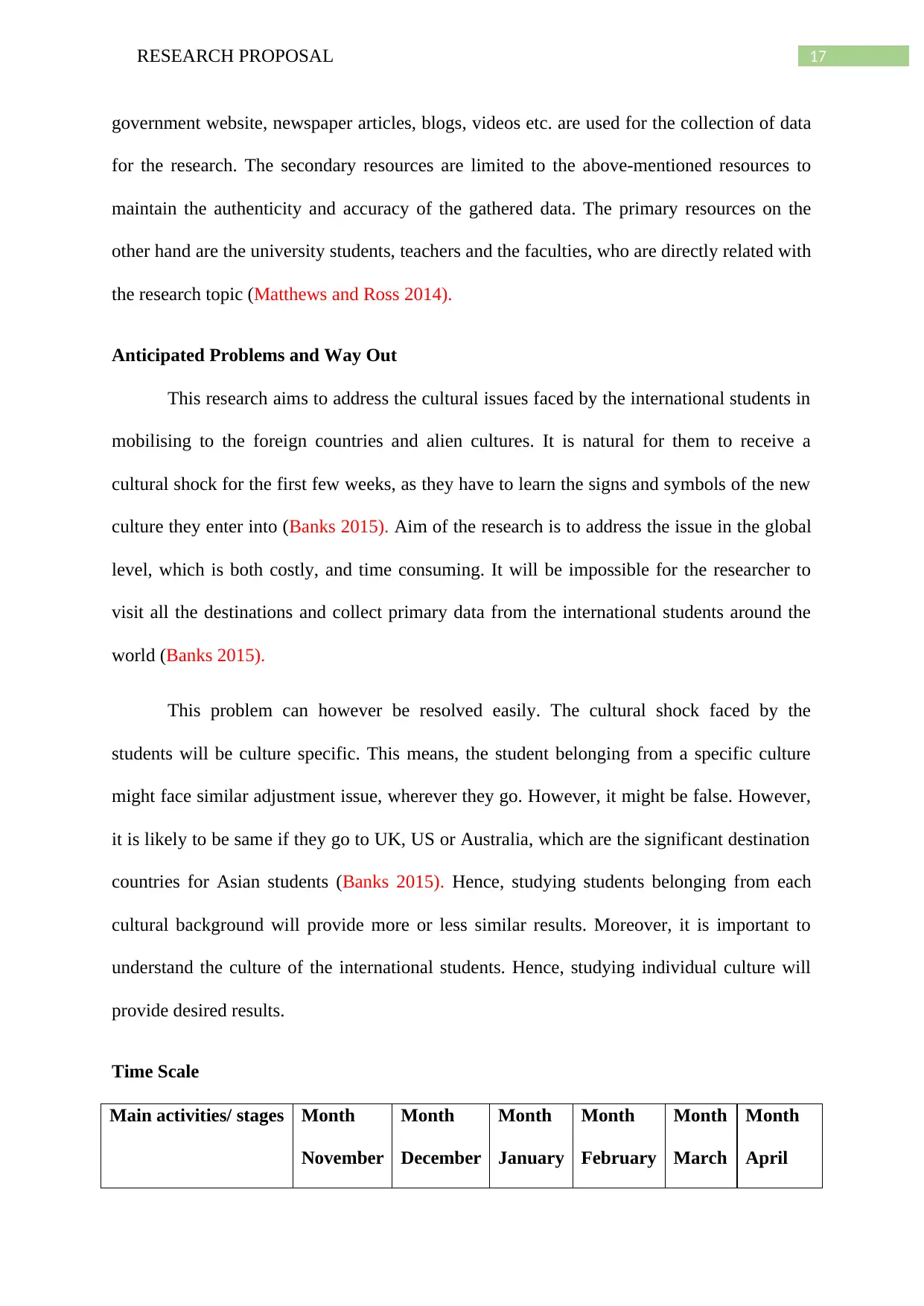
17RESEARCH PROPOSAL
government website, newspaper articles, blogs, videos etc. are used for the collection of data
for the research. The secondary resources are limited to the above-mentioned resources to
maintain the authenticity and accuracy of the gathered data. The primary resources on the
other hand are the university students, teachers and the faculties, who are directly related with
the research topic (Matthews and Ross 2014).
Anticipated Problems and Way Out
This research aims to address the cultural issues faced by the international students in
mobilising to the foreign countries and alien cultures. It is natural for them to receive a
cultural shock for the first few weeks, as they have to learn the signs and symbols of the new
culture they enter into (Banks 2015). Aim of the research is to address the issue in the global
level, which is both costly, and time consuming. It will be impossible for the researcher to
visit all the destinations and collect primary data from the international students around the
world (Banks 2015).
This problem can however be resolved easily. The cultural shock faced by the
students will be culture specific. This means, the student belonging from a specific culture
might face similar adjustment issue, wherever they go. However, it might be false. However,
it is likely to be same if they go to UK, US or Australia, which are the significant destination
countries for Asian students (Banks 2015). Hence, studying students belonging from each
cultural background will provide more or less similar results. Moreover, it is important to
understand the culture of the international students. Hence, studying individual culture will
provide desired results.
Time Scale
Main activities/ stages Month
November
Month
December
Month
January
Month
February
Month
March
Month
April
government website, newspaper articles, blogs, videos etc. are used for the collection of data
for the research. The secondary resources are limited to the above-mentioned resources to
maintain the authenticity and accuracy of the gathered data. The primary resources on the
other hand are the university students, teachers and the faculties, who are directly related with
the research topic (Matthews and Ross 2014).
Anticipated Problems and Way Out
This research aims to address the cultural issues faced by the international students in
mobilising to the foreign countries and alien cultures. It is natural for them to receive a
cultural shock for the first few weeks, as they have to learn the signs and symbols of the new
culture they enter into (Banks 2015). Aim of the research is to address the issue in the global
level, which is both costly, and time consuming. It will be impossible for the researcher to
visit all the destinations and collect primary data from the international students around the
world (Banks 2015).
This problem can however be resolved easily. The cultural shock faced by the
students will be culture specific. This means, the student belonging from a specific culture
might face similar adjustment issue, wherever they go. However, it might be false. However,
it is likely to be same if they go to UK, US or Australia, which are the significant destination
countries for Asian students (Banks 2015). Hence, studying students belonging from each
cultural background will provide more or less similar results. Moreover, it is important to
understand the culture of the international students. Hence, studying individual culture will
provide desired results.
Time Scale
Main activities/ stages Month
November
Month
December
Month
January
Month
February
Month
March
Month
April
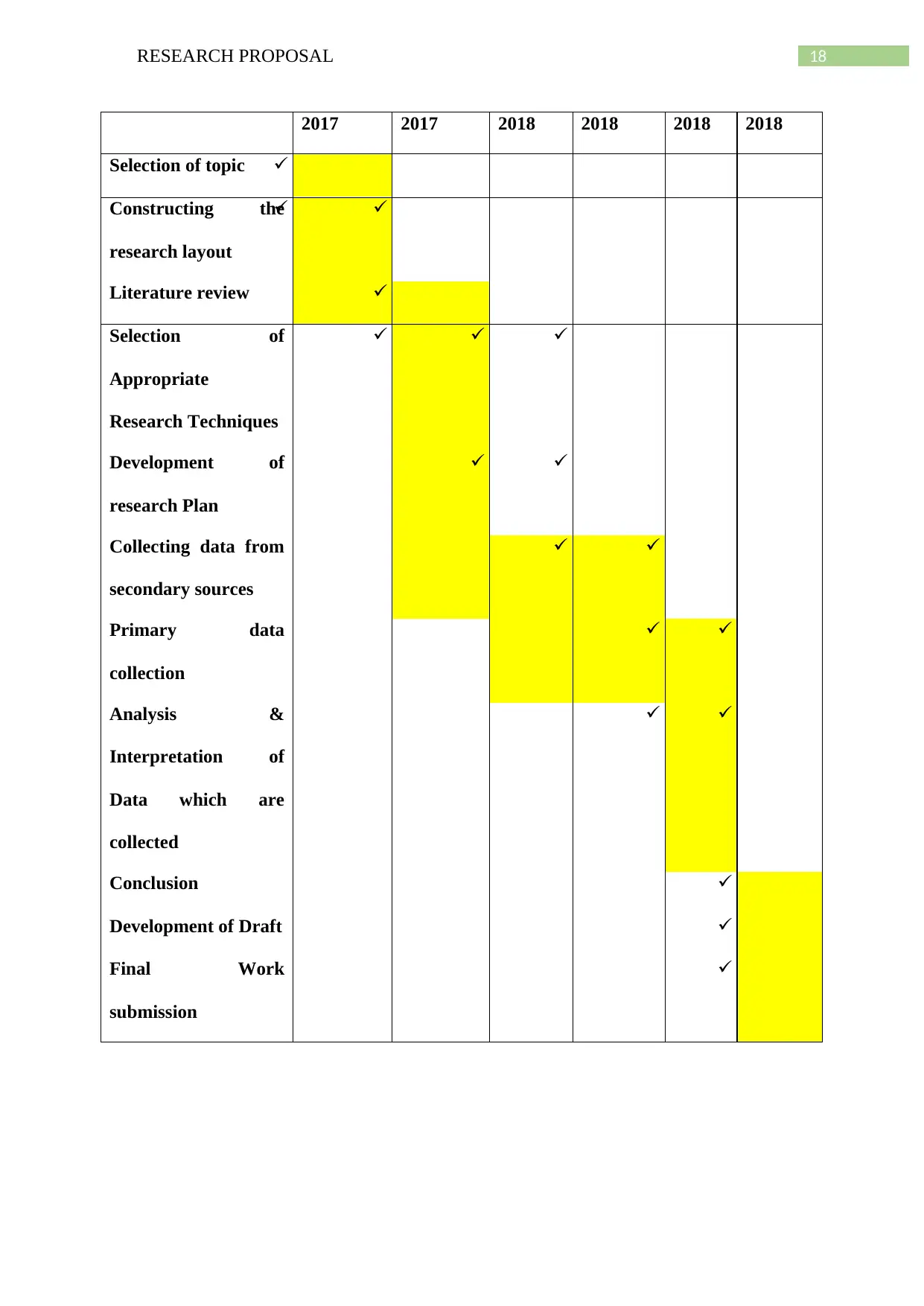
18RESEARCH PROPOSAL
2017 2017 2018 2018 2018 2018
Selection of topic
Constructing the
research layout
Literature review
Selection of
Appropriate
Research Techniques
Development of
research Plan
Collecting data from
secondary sources
Primary data
collection
Analysis &
Interpretation of
Data which are
collected
Conclusion
Development of Draft
Final Work
submission
2017 2017 2018 2018 2018 2018
Selection of topic
Constructing the
research layout
Literature review
Selection of
Appropriate
Research Techniques
Development of
research Plan
Collecting data from
secondary sources
Primary data
collection
Analysis &
Interpretation of
Data which are
collected
Conclusion
Development of Draft
Final Work
submission
Paraphrase This Document
Need a fresh take? Get an instant paraphrase of this document with our AI Paraphraser
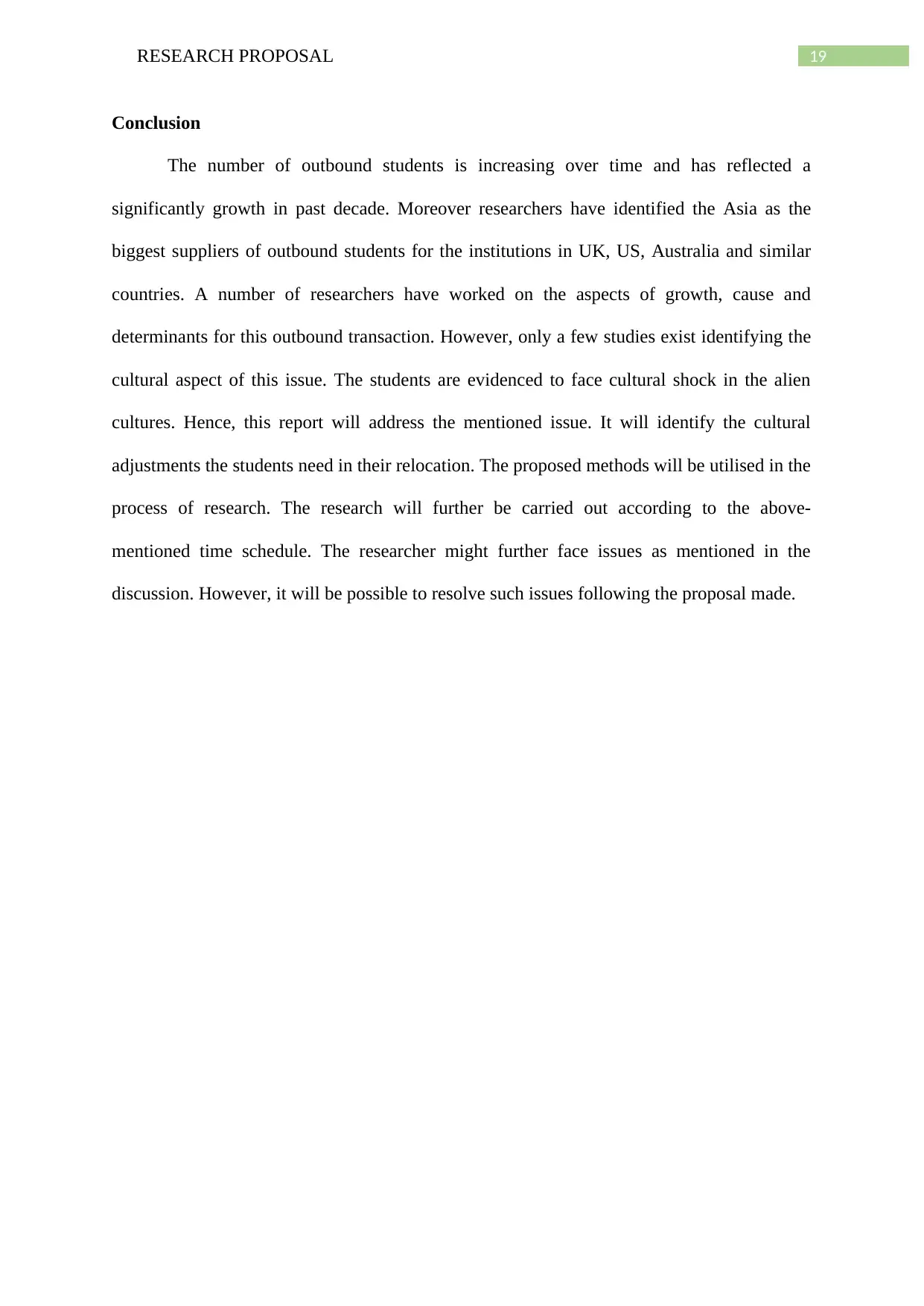
19RESEARCH PROPOSAL
Conclusion
The number of outbound students is increasing over time and has reflected a
significantly growth in past decade. Moreover researchers have identified the Asia as the
biggest suppliers of outbound students for the institutions in UK, US, Australia and similar
countries. A number of researchers have worked on the aspects of growth, cause and
determinants for this outbound transaction. However, only a few studies exist identifying the
cultural aspect of this issue. The students are evidenced to face cultural shock in the alien
cultures. Hence, this report will address the mentioned issue. It will identify the cultural
adjustments the students need in their relocation. The proposed methods will be utilised in the
process of research. The research will further be carried out according to the above-
mentioned time schedule. The researcher might further face issues as mentioned in the
discussion. However, it will be possible to resolve such issues following the proposal made.
Conclusion
The number of outbound students is increasing over time and has reflected a
significantly growth in past decade. Moreover researchers have identified the Asia as the
biggest suppliers of outbound students for the institutions in UK, US, Australia and similar
countries. A number of researchers have worked on the aspects of growth, cause and
determinants for this outbound transaction. However, only a few studies exist identifying the
cultural aspect of this issue. The students are evidenced to face cultural shock in the alien
cultures. Hence, this report will address the mentioned issue. It will identify the cultural
adjustments the students need in their relocation. The proposed methods will be utilised in the
process of research. The research will further be carried out according to the above-
mentioned time schedule. The researcher might further face issues as mentioned in the
discussion. However, it will be possible to resolve such issues following the proposal made.
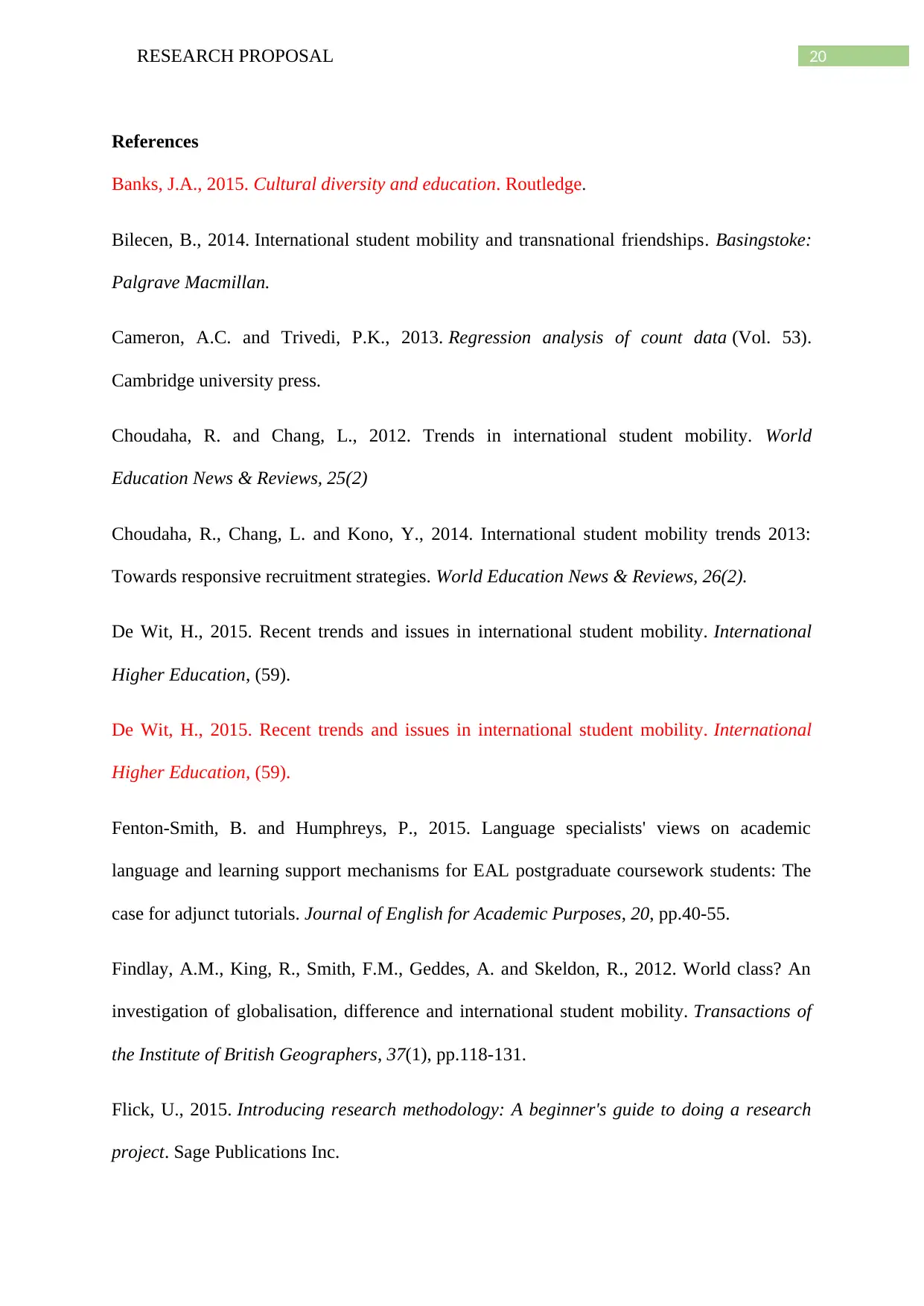
20RESEARCH PROPOSAL
References
Banks, J.A., 2015. Cultural diversity and education. Routledge.
Bilecen, B., 2014. International student mobility and transnational friendships. Basingstoke:
Palgrave Macmillan.
Cameron, A.C. and Trivedi, P.K., 2013. Regression analysis of count data (Vol. 53).
Cambridge university press.
Choudaha, R. and Chang, L., 2012. Trends in international student mobility. World
Education News & Reviews, 25(2)
Choudaha, R., Chang, L. and Kono, Y., 2014. International student mobility trends 2013:
Towards responsive recruitment strategies. World Education News & Reviews, 26(2).
De Wit, H., 2015. Recent trends and issues in international student mobility. International
Higher Education, (59).
De Wit, H., 2015. Recent trends and issues in international student mobility. International
Higher Education, (59).
Fenton-Smith, B. and Humphreys, P., 2015. Language specialists' views on academic
language and learning support mechanisms for EAL postgraduate coursework students: The
case for adjunct tutorials. Journal of English for Academic Purposes, 20, pp.40-55.
Findlay, A.M., King, R., Smith, F.M., Geddes, A. and Skeldon, R., 2012. World class? An
investigation of globalisation, difference and international student mobility. Transactions of
the Institute of British Geographers, 37(1), pp.118-131.
Flick, U., 2015. Introducing research methodology: A beginner's guide to doing a research
project. Sage Publications Inc.
References
Banks, J.A., 2015. Cultural diversity and education. Routledge.
Bilecen, B., 2014. International student mobility and transnational friendships. Basingstoke:
Palgrave Macmillan.
Cameron, A.C. and Trivedi, P.K., 2013. Regression analysis of count data (Vol. 53).
Cambridge university press.
Choudaha, R. and Chang, L., 2012. Trends in international student mobility. World
Education News & Reviews, 25(2)
Choudaha, R., Chang, L. and Kono, Y., 2014. International student mobility trends 2013:
Towards responsive recruitment strategies. World Education News & Reviews, 26(2).
De Wit, H., 2015. Recent trends and issues in international student mobility. International
Higher Education, (59).
De Wit, H., 2015. Recent trends and issues in international student mobility. International
Higher Education, (59).
Fenton-Smith, B. and Humphreys, P., 2015. Language specialists' views on academic
language and learning support mechanisms for EAL postgraduate coursework students: The
case for adjunct tutorials. Journal of English for Academic Purposes, 20, pp.40-55.
Findlay, A.M., King, R., Smith, F.M., Geddes, A. and Skeldon, R., 2012. World class? An
investigation of globalisation, difference and international student mobility. Transactions of
the Institute of British Geographers, 37(1), pp.118-131.
Flick, U., 2015. Introducing research methodology: A beginner's guide to doing a research
project. Sage Publications Inc.
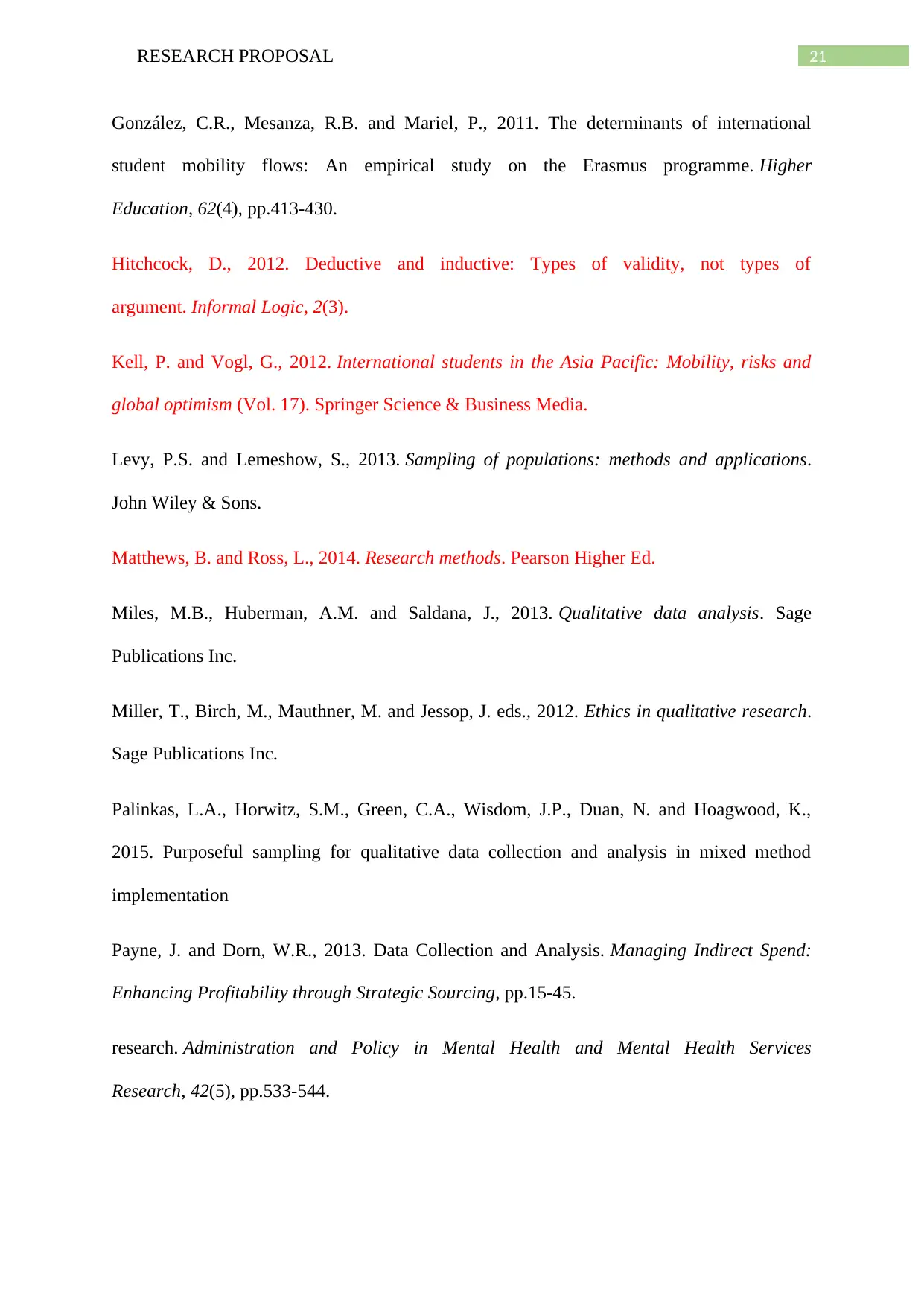
21RESEARCH PROPOSAL
González, C.R., Mesanza, R.B. and Mariel, P., 2011. The determinants of international
student mobility flows: An empirical study on the Erasmus programme. Higher
Education, 62(4), pp.413-430.
Hitchcock, D., 2012. Deductive and inductive: Types of validity, not types of
argument. Informal Logic, 2(3).
Kell, P. and Vogl, G., 2012. International students in the Asia Pacific: Mobility, risks and
global optimism (Vol. 17). Springer Science & Business Media.
Levy, P.S. and Lemeshow, S., 2013. Sampling of populations: methods and applications.
John Wiley & Sons.
Matthews, B. and Ross, L., 2014. Research methods. Pearson Higher Ed.
Miles, M.B., Huberman, A.M. and Saldana, J., 2013. Qualitative data analysis. Sage
Publications Inc.
Miller, T., Birch, M., Mauthner, M. and Jessop, J. eds., 2012. Ethics in qualitative research.
Sage Publications Inc.
Palinkas, L.A., Horwitz, S.M., Green, C.A., Wisdom, J.P., Duan, N. and Hoagwood, K.,
2015. Purposeful sampling for qualitative data collection and analysis in mixed method
implementation
Payne, J. and Dorn, W.R., 2013. Data Collection and Analysis. Managing Indirect Spend:
Enhancing Profitability through Strategic Sourcing, pp.15-45.
research. Administration and Policy in Mental Health and Mental Health Services
Research, 42(5), pp.533-544.
González, C.R., Mesanza, R.B. and Mariel, P., 2011. The determinants of international
student mobility flows: An empirical study on the Erasmus programme. Higher
Education, 62(4), pp.413-430.
Hitchcock, D., 2012. Deductive and inductive: Types of validity, not types of
argument. Informal Logic, 2(3).
Kell, P. and Vogl, G., 2012. International students in the Asia Pacific: Mobility, risks and
global optimism (Vol. 17). Springer Science & Business Media.
Levy, P.S. and Lemeshow, S., 2013. Sampling of populations: methods and applications.
John Wiley & Sons.
Matthews, B. and Ross, L., 2014. Research methods. Pearson Higher Ed.
Miles, M.B., Huberman, A.M. and Saldana, J., 2013. Qualitative data analysis. Sage
Publications Inc.
Miller, T., Birch, M., Mauthner, M. and Jessop, J. eds., 2012. Ethics in qualitative research.
Sage Publications Inc.
Palinkas, L.A., Horwitz, S.M., Green, C.A., Wisdom, J.P., Duan, N. and Hoagwood, K.,
2015. Purposeful sampling for qualitative data collection and analysis in mixed method
implementation
Payne, J. and Dorn, W.R., 2013. Data Collection and Analysis. Managing Indirect Spend:
Enhancing Profitability through Strategic Sourcing, pp.15-45.
research. Administration and Policy in Mental Health and Mental Health Services
Research, 42(5), pp.533-544.
Secure Best Marks with AI Grader
Need help grading? Try our AI Grader for instant feedback on your assignments.

22RESEARCH PROPOSAL
Sekaran, U. and Bougie, R., 2016. Research methods for business: A skill building approach.
John Wiley & Sons.
She, Q. and Wotherspoon, T., 2013. International student mobility and highly skilled
migration: A comparative study of Canada, the United States, and the United
Kingdom. SpringerPlus, 2(1), p.132.
Shields, R., 2013. Globalization and international student mobility: A network
analysis. Comparative Education Review, 57(4), pp.609-636.
Treiman, D.J., 2014. Quantitative data analysis: Doing social research to test ideas. John
Wiley & Sons.
Waltman, L., Calero‐Medina, C., Kosten, J., Noyons, E., Tijssen, R.J., Eck, N.J., Leeuwen,
T.N., Raan, A.F., Visser, M.S. and Wouters, P., 2012. The Leiden Ranking 2011/2012: Data
collection, indicators, and interpretation. Journal of the Association for Information Science
and Technology, 63(12), pp.2419-2432.
Wei, H., 2013. An empirical study on the determinants of international student mobility: a
global perspective. Higher Education, 66(1), pp.105-122.
Sekaran, U. and Bougie, R., 2016. Research methods for business: A skill building approach.
John Wiley & Sons.
She, Q. and Wotherspoon, T., 2013. International student mobility and highly skilled
migration: A comparative study of Canada, the United States, and the United
Kingdom. SpringerPlus, 2(1), p.132.
Shields, R., 2013. Globalization and international student mobility: A network
analysis. Comparative Education Review, 57(4), pp.609-636.
Treiman, D.J., 2014. Quantitative data analysis: Doing social research to test ideas. John
Wiley & Sons.
Waltman, L., Calero‐Medina, C., Kosten, J., Noyons, E., Tijssen, R.J., Eck, N.J., Leeuwen,
T.N., Raan, A.F., Visser, M.S. and Wouters, P., 2012. The Leiden Ranking 2011/2012: Data
collection, indicators, and interpretation. Journal of the Association for Information Science
and Technology, 63(12), pp.2419-2432.
Wei, H., 2013. An empirical study on the determinants of international student mobility: a
global perspective. Higher Education, 66(1), pp.105-122.
1 out of 23
Related Documents
Your All-in-One AI-Powered Toolkit for Academic Success.
+13062052269
info@desklib.com
Available 24*7 on WhatsApp / Email
![[object Object]](/_next/static/media/star-bottom.7253800d.svg)
Unlock your academic potential
© 2024 | Zucol Services PVT LTD | All rights reserved.





